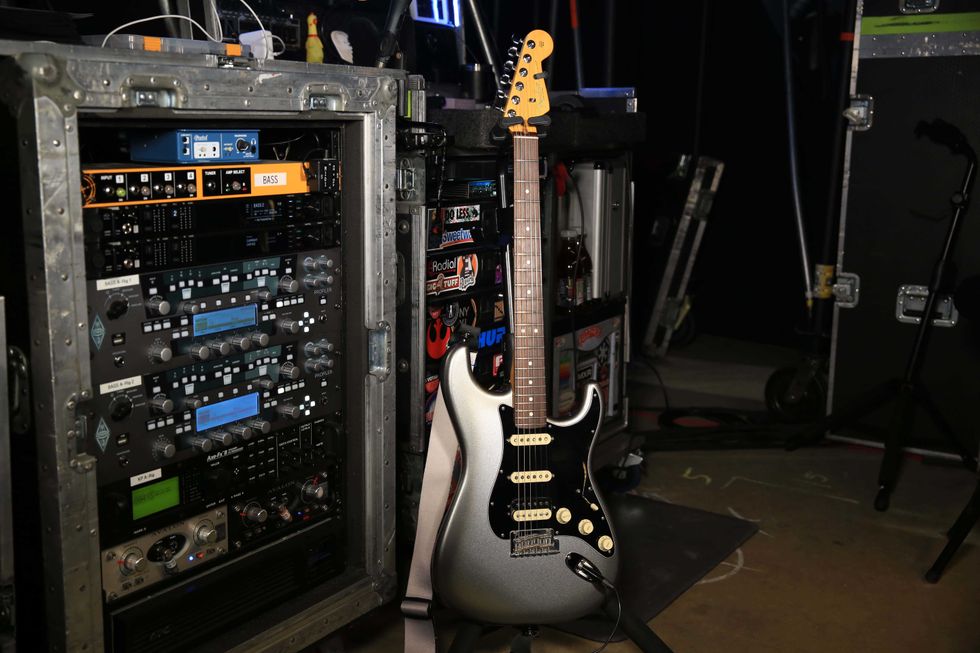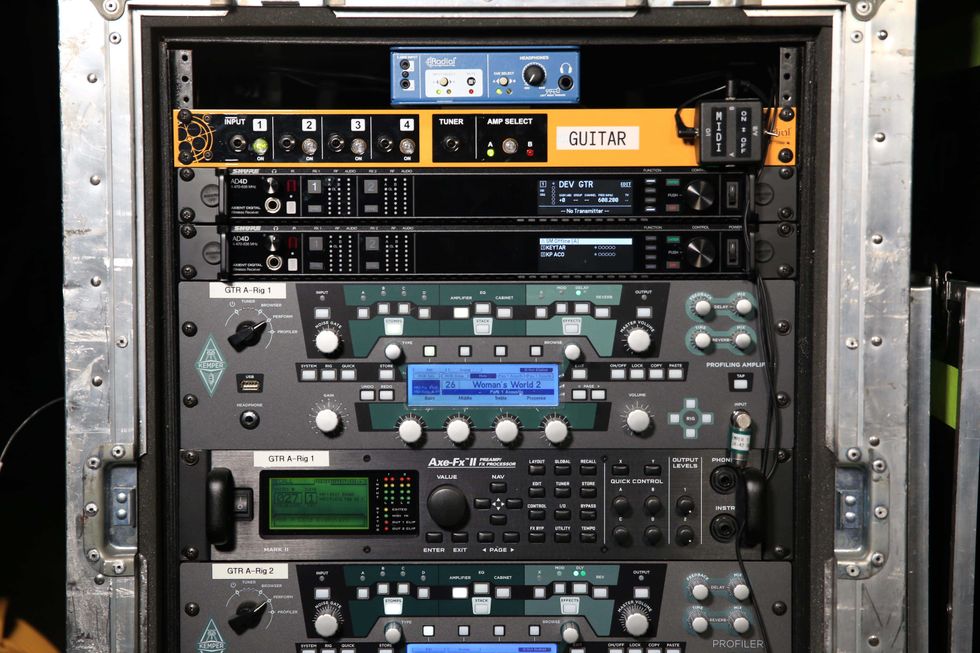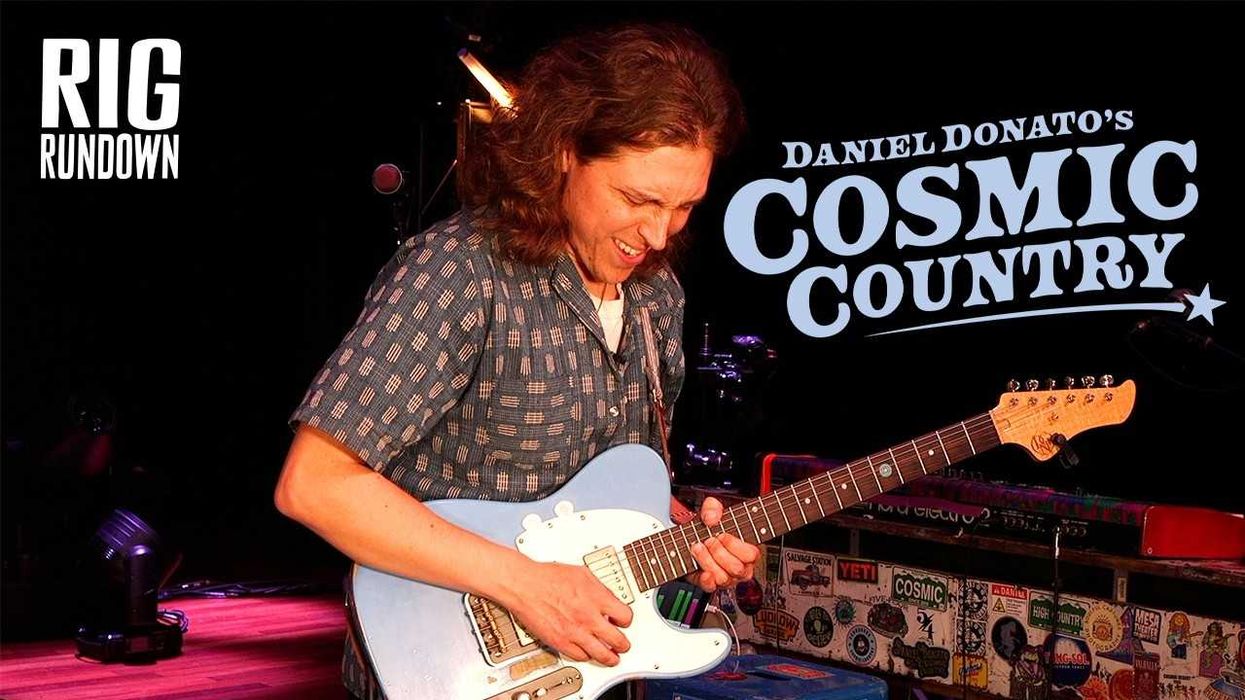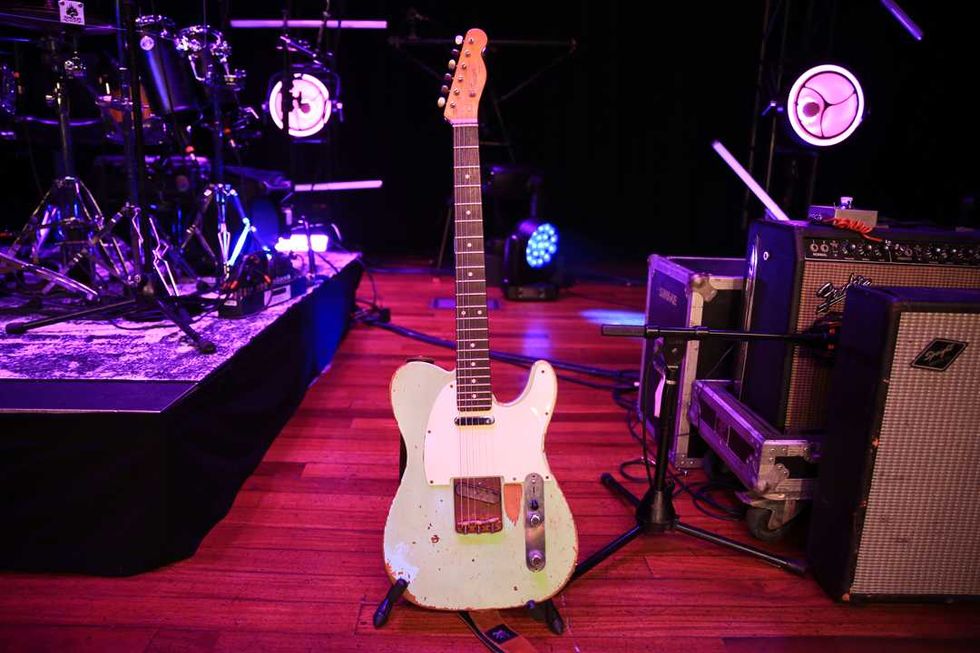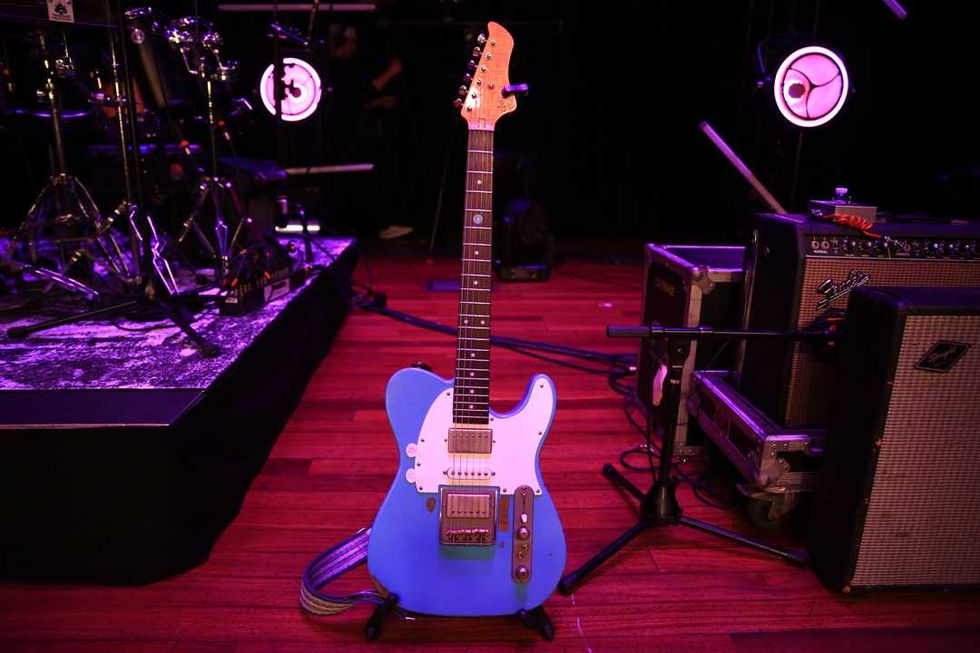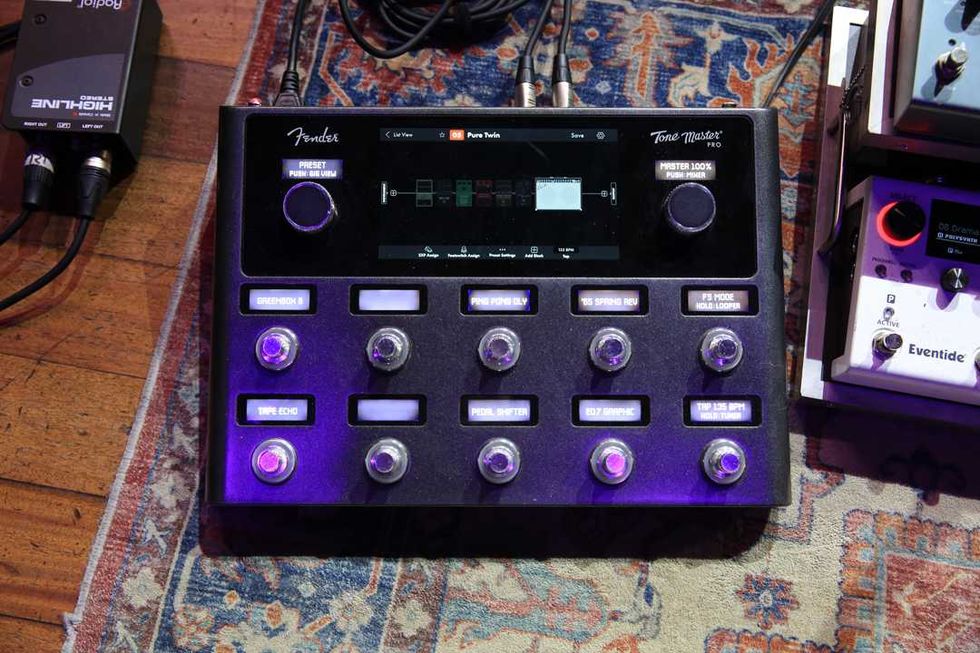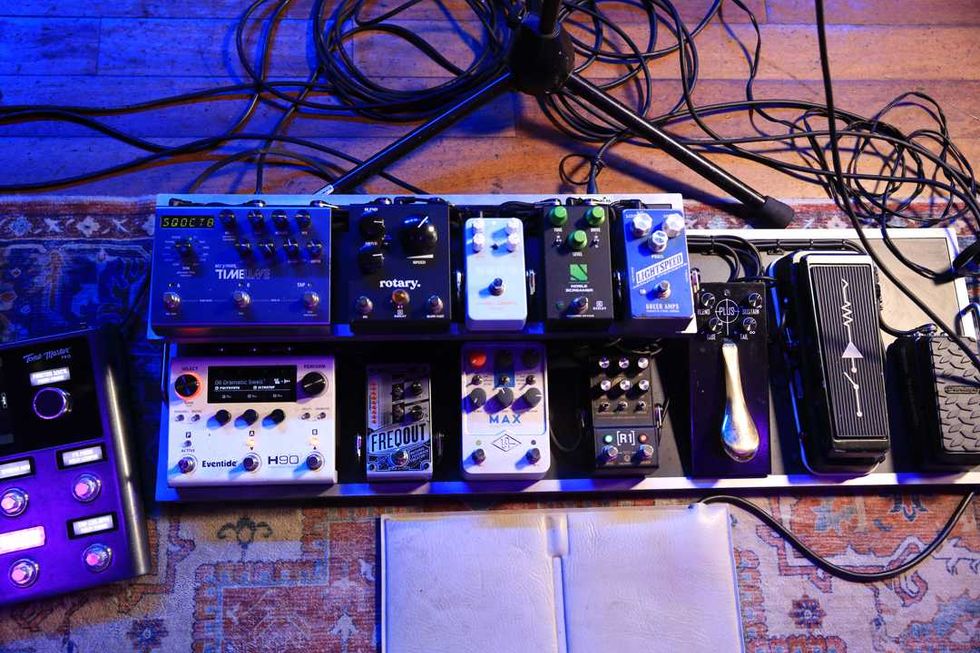Like King Ghidorah, these rock fretmasters prove three heads are better than one.
After a five-year break in studio releases, Train came roaring back this year with AM Gold and a tour with dates stretching into 2023 that’s delivering their new songs and a sampling of the group’s 28 charting singles from their nearly 30-year history. PG’s John Bohlinger stopped in on the band’s two guitar players, Jerry Becker and Taylor Locke, and bassist Hector Maldonado, before their June 21 show at Nashville’s Ascend Amphitheater. They displayed the big bevy of instruments they use to recreate the Train sound live.
PS: Special thanks to techs Wayne Davis and Stephen Ferrera-Grand for help running down the rigs.
Brought to you by D’Addario Nexxus 360 Tuner.
Yellow Fever
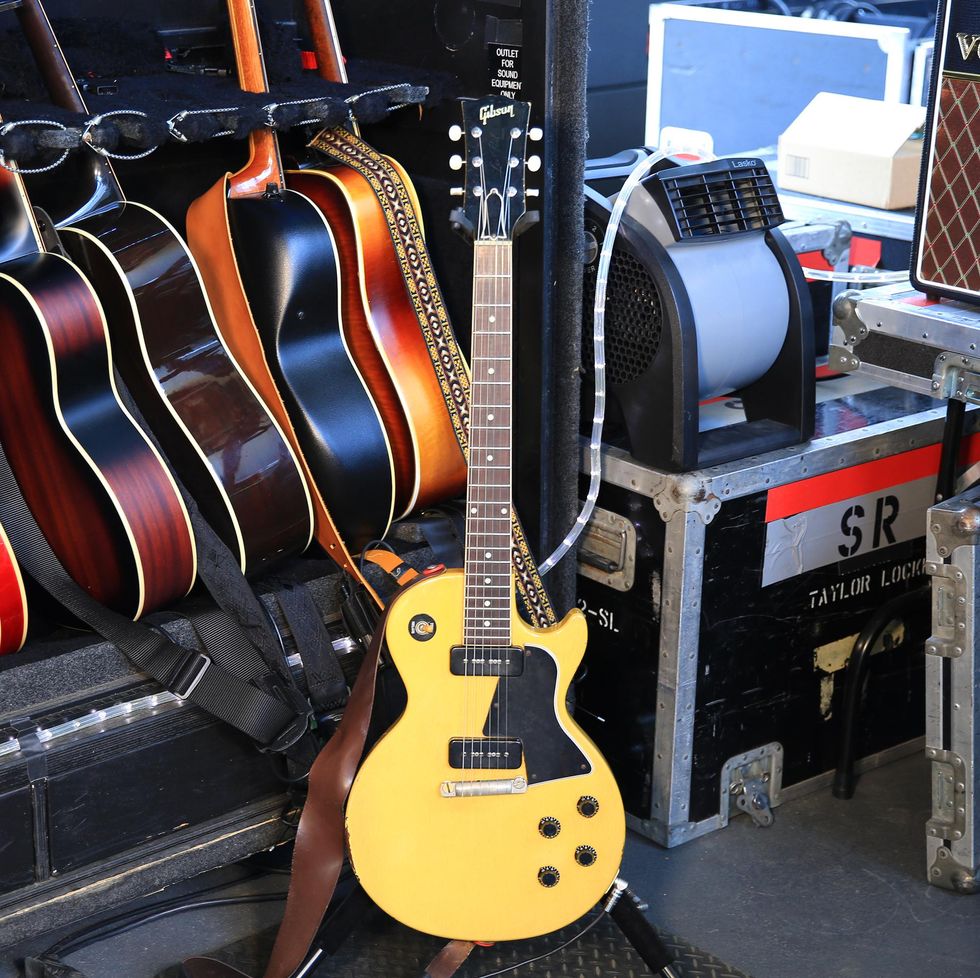
Taylor Locke’s No. 1 is this all-stock, scarred Gibson Custom Shop Les Paul Special in TV yellow. For the record, Locke uses Shubb and Kyser capos, strings his axes with Dunlops, and uses the latter company’s picks and slides.
Hum-Doozie
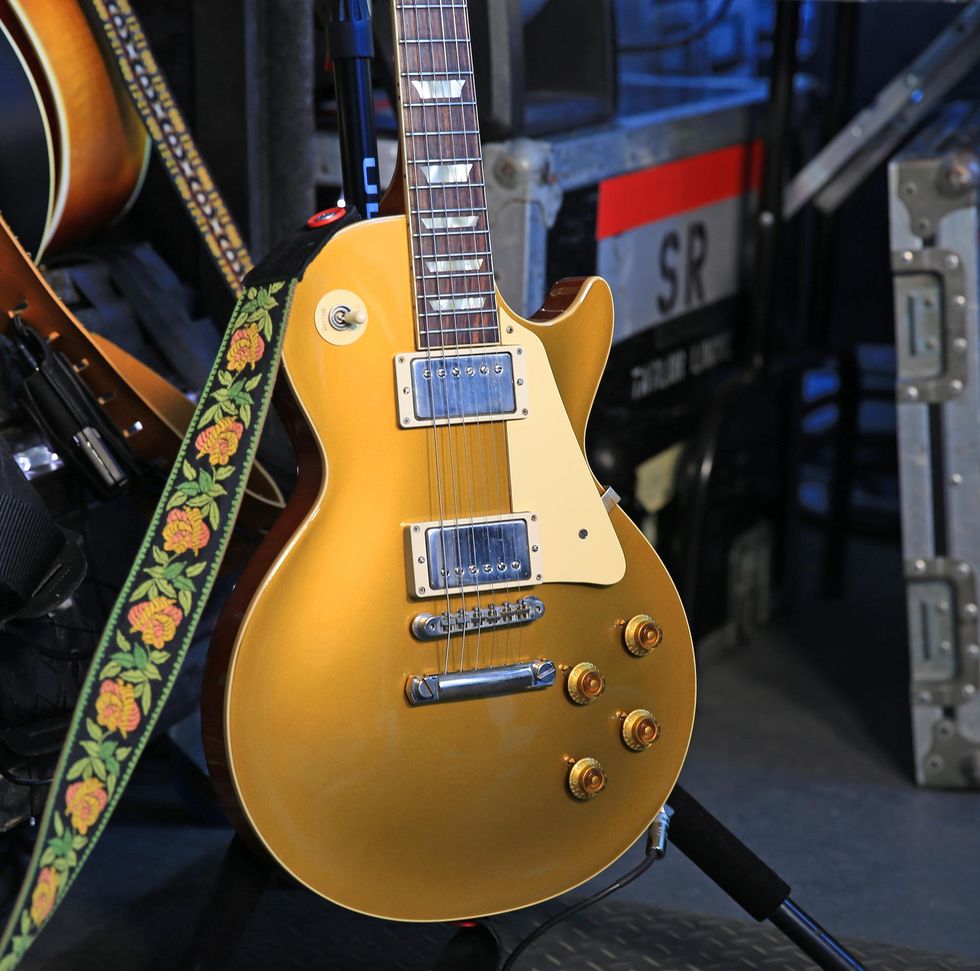
When the song calls for a guitar with humbuckers, Locke goes with his all-stock Gibson Custom Shop R7 Les Paul Goldtop. It’s essentially a re-do of a 1957 Paul right down to the chunky C-profile neck and Indian rosewood fretboard.
Double Trouble
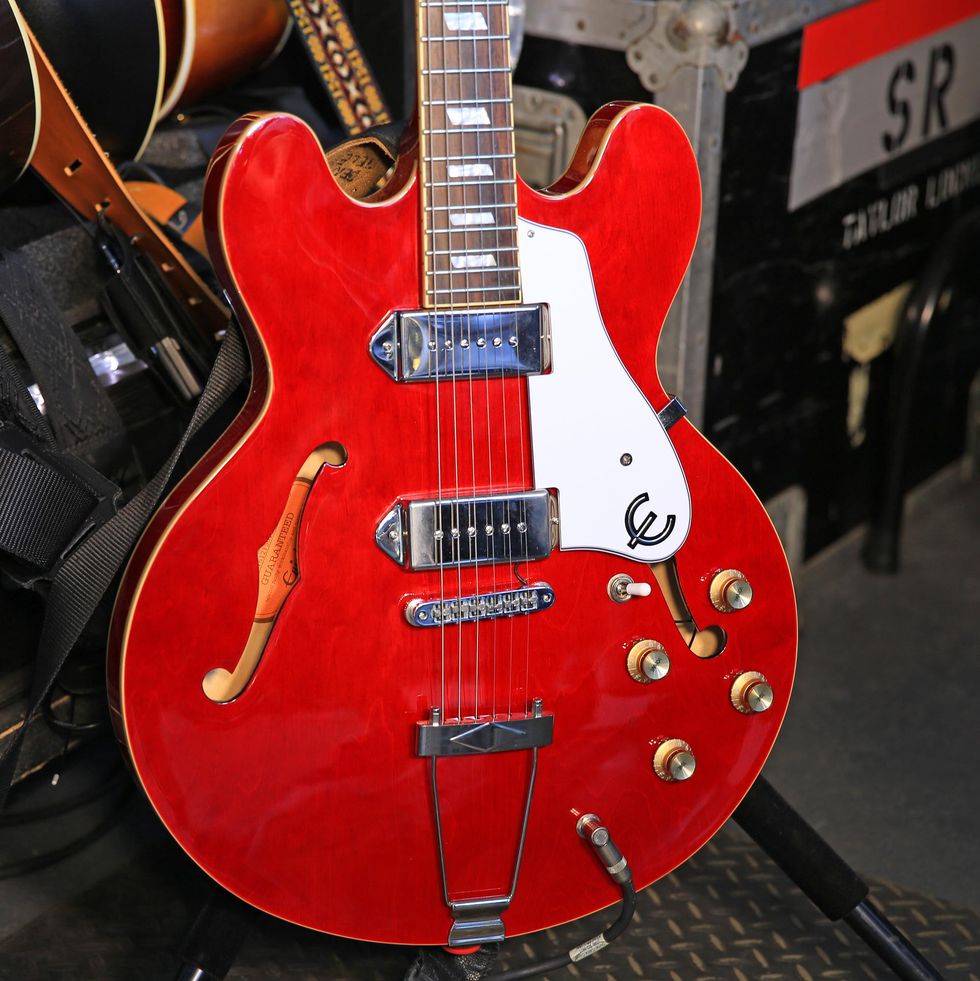
Some of Train’s songs require both electric and acoustic tones, and for those Taylor employs an Epiphone Casino, which tech Stephen Ferrera-Grand has outfitted with Fishman’s PowerBridge pickup system. The jack on the Casino is stereo, which enables splitting the stock electric pickups and a piezo pickup to two separate wireless packs, mounted side-by-side on Taylor’s guitar strap. The piezo signal hits a Sound Sculpture Volcano expression pedal volume controller that routes to an on/off switch on his Line 6 HX Effects stomper. The piezo sound is sent to front-of-house and monitors via a Fishman Aura Spectrum DI preamp.
Fab Filtration Across the Nation

When it’s time to go Filter’Tron, Locke straps on this tuxedo’d G6128T Vintage Select ’89 Duo Jet with a trusty Bigsby. In case the colors aren’t shining though in the photo, it’s an impressive black with metallic green sparkle, and Locke keeps it tuned a half-step down and strung with Dunlop .011s
Old Frontier
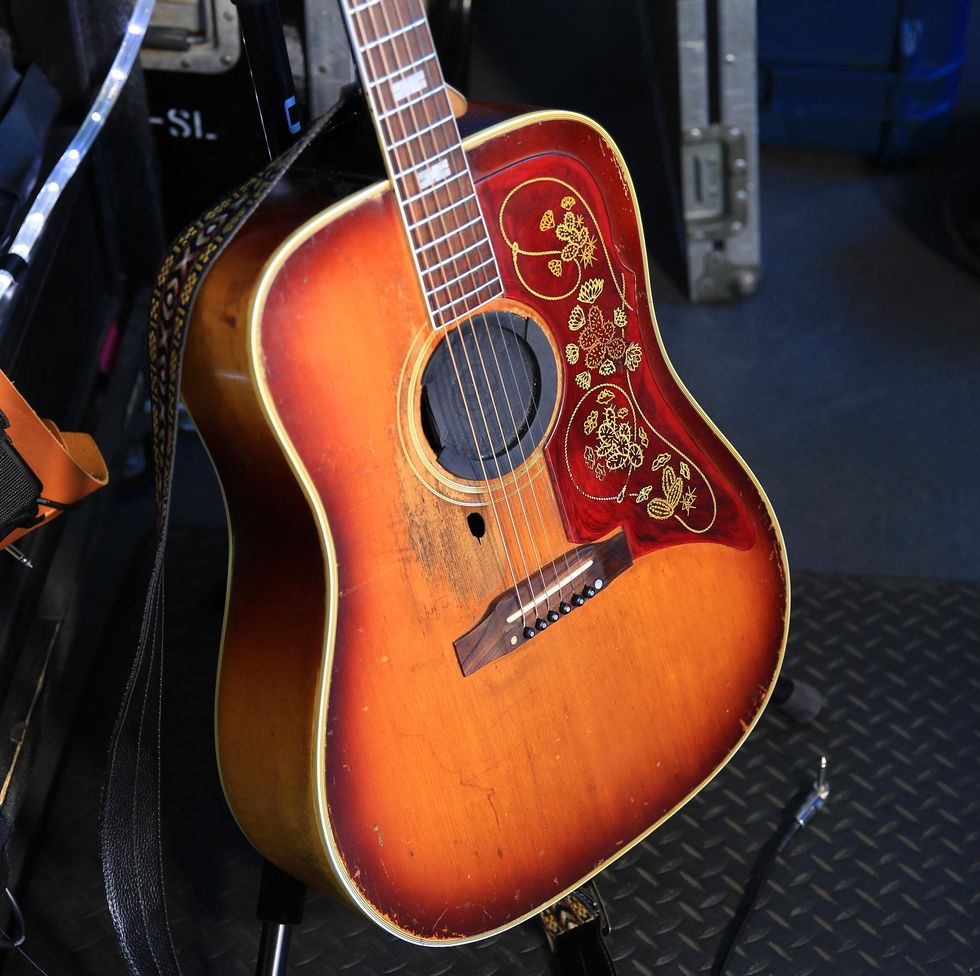
Locke aims for a couple of classic acoustic guitar tones, and for vintage vibe he reaches for this 1964 Epiphone Frontier. It’s from the original ’58 to ’70 run, with a Sitka spruce top and maple back and sides. These days, the model has been restored to the catalog courtesy of Gibson’s acoustic builders in Bozeman, Montana.
Clydesdale Tone

The workhorse sound of the Gibson J-45 resonates in the Train catalog, and this is one of many the band keeps in their 6-string arsenal.
Reso-Phonics
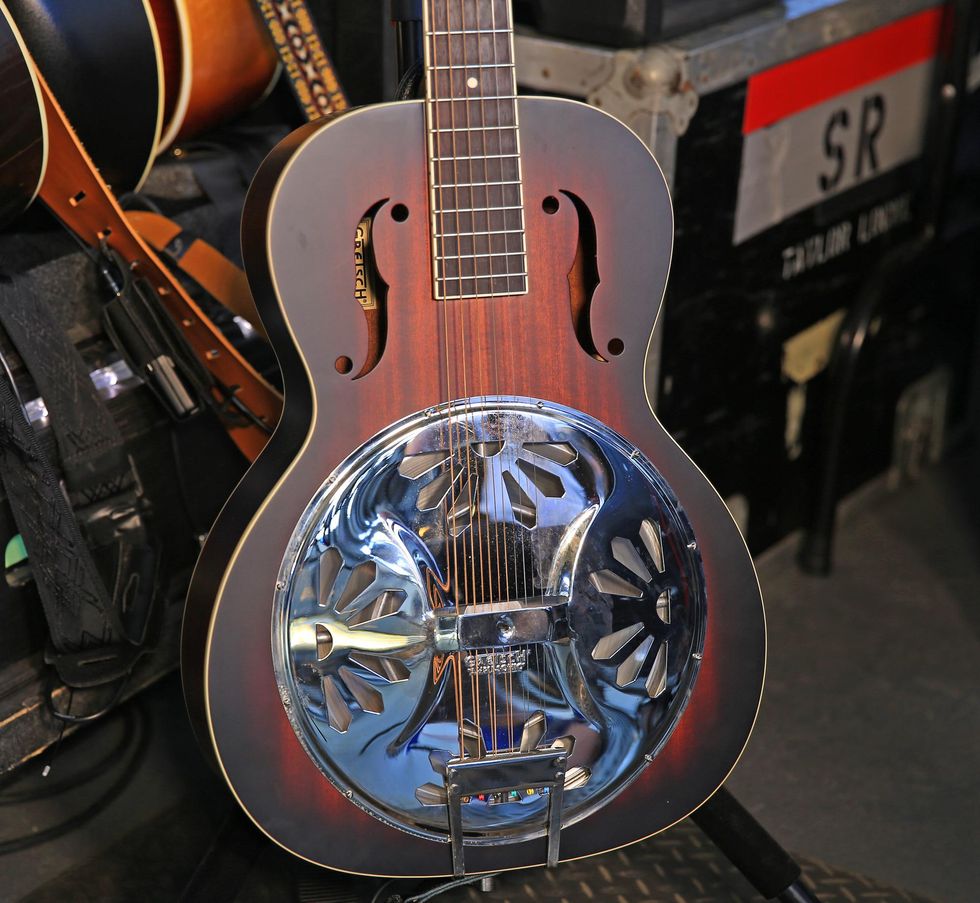
When the language of roots guitar needs to be spoken, Locke grabs his Gretsch resonator—part of the company’s Roots Collection of guitars. This one uses Gretsch’s patented Ampli-Sonic biscuit cone.
Playing the Dozens

When it’s time to wrangle acoustic jangle, this all-stock 1971 Ovation Glen Campbell 12-string gets to shine and shimmer. Unlike modern 6-string Campbell signature Ovations, this guitar lacks a cutaway. It has a Sitka spruce top, a walnut bridge, and an ebony fretboard—and sounds killer.
It’s Pronounced Oo-koo-lay-lay in Hawaiian
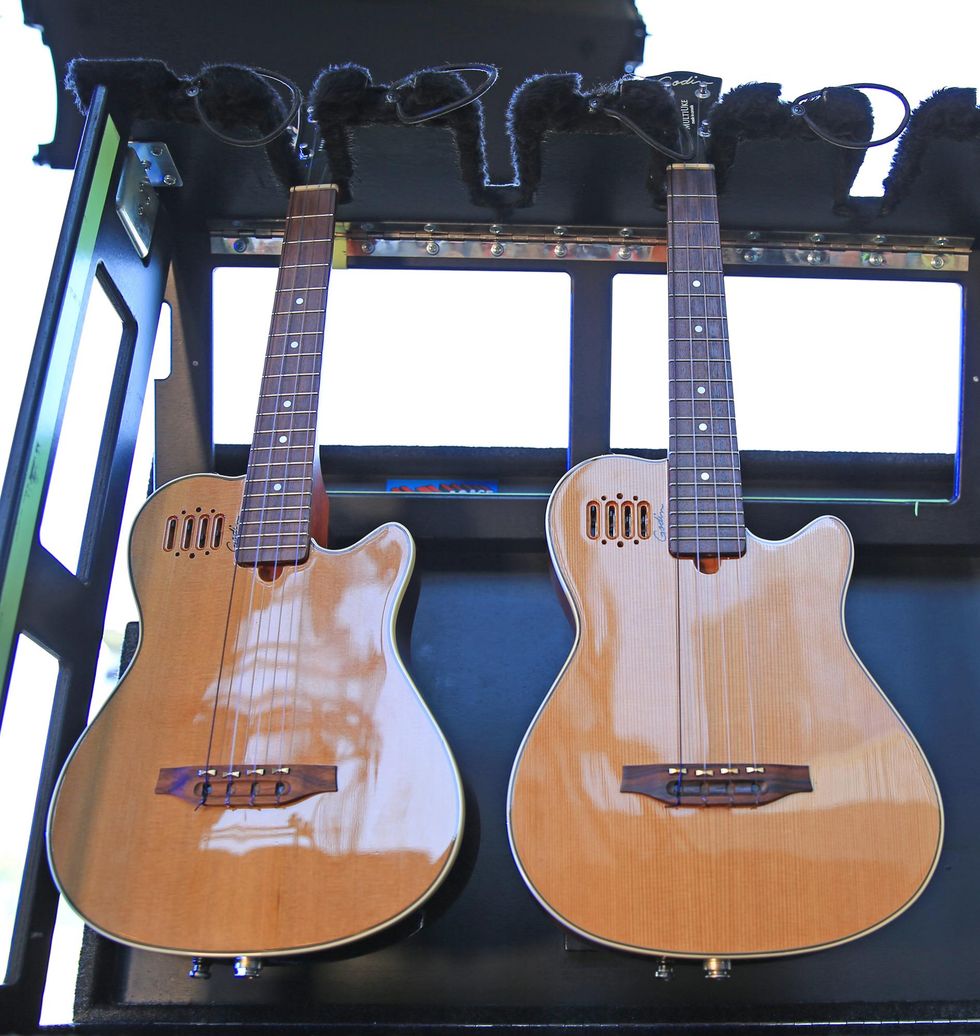
The hit “Hey, Soul Sister,” which reached No. 3 on Billboard’s pop chart in 2009, is guaranteed set-list material for every show. So, of course, Locke always has a requisite ukulele onstage. Here’s a look at the pair of Godin ukes in his rack.
Lean, No Cheese, 35 Watts
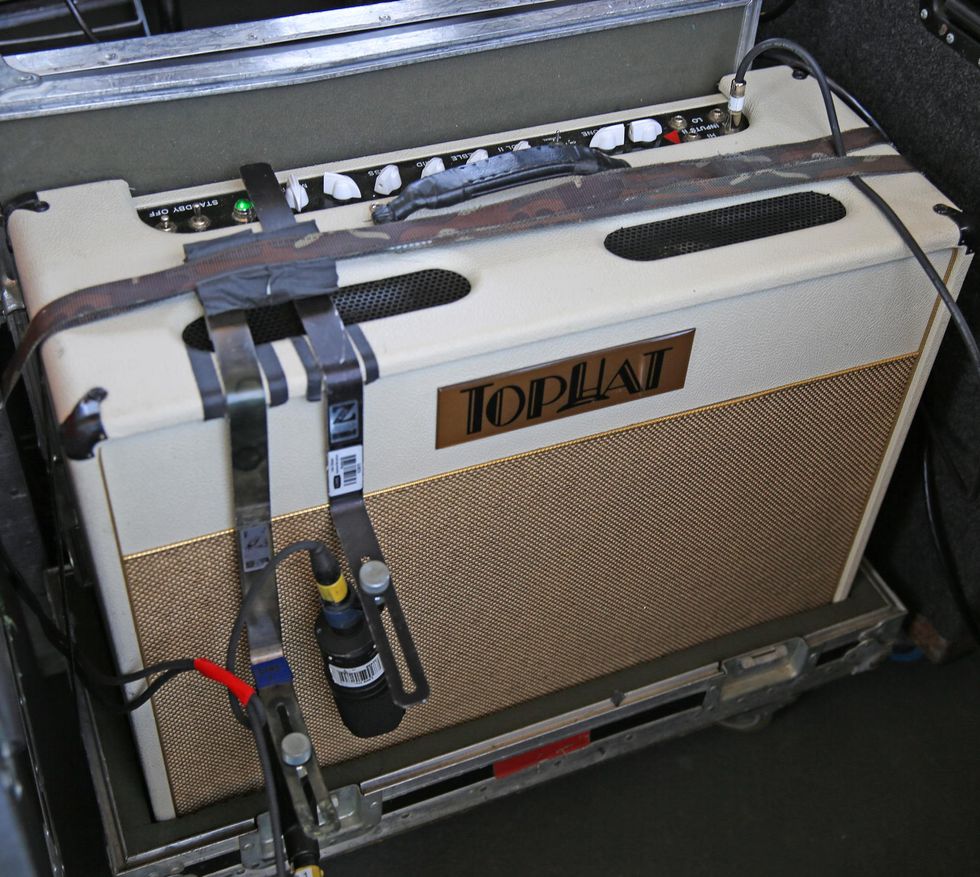
Locke uses a Top Hat King Royal 2x12 combo kept slightly off stage but loud enough to be audible. The 35-watter has three 12AX7s and four EL84 power tubes, and a GZ34 governing the rectifier. There’s a fat-off-bright switch, too. How does he run it? See the next photo.
All Set!
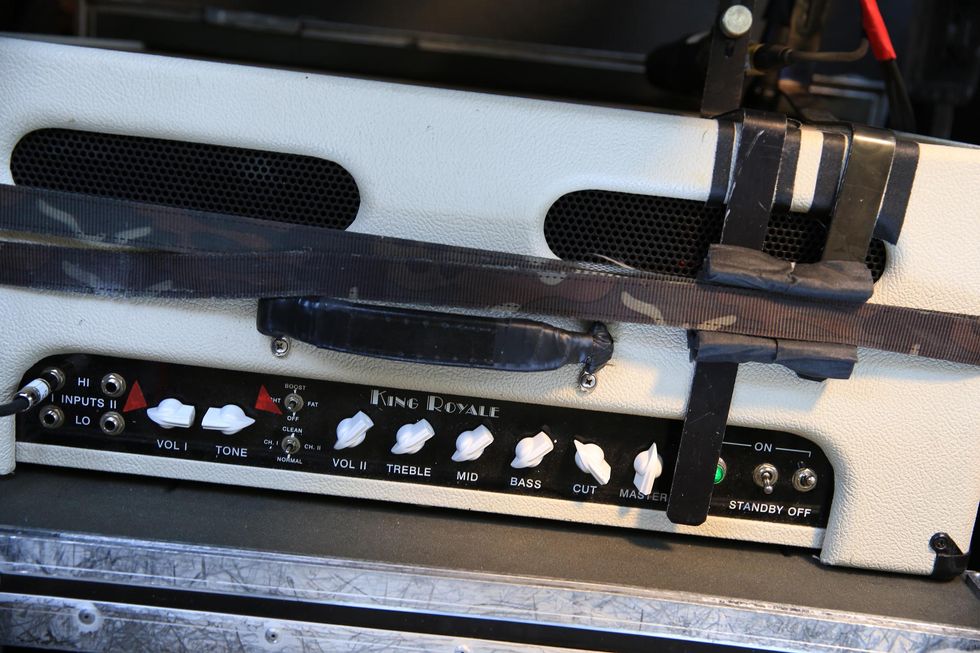
Here are his settings for the Top Hat. Note the master volume riding at 1 o’clock and his preference for the hi-input jack.
Is That a Banana, or….

Locke isn’t monkeying around: If his Top Hat goes down, he’s got a Vox C4 tucked aside as a spare. And a banana—maybe to snack on while Ferrera-Grand powers the amp up?
The Great Switcheroo
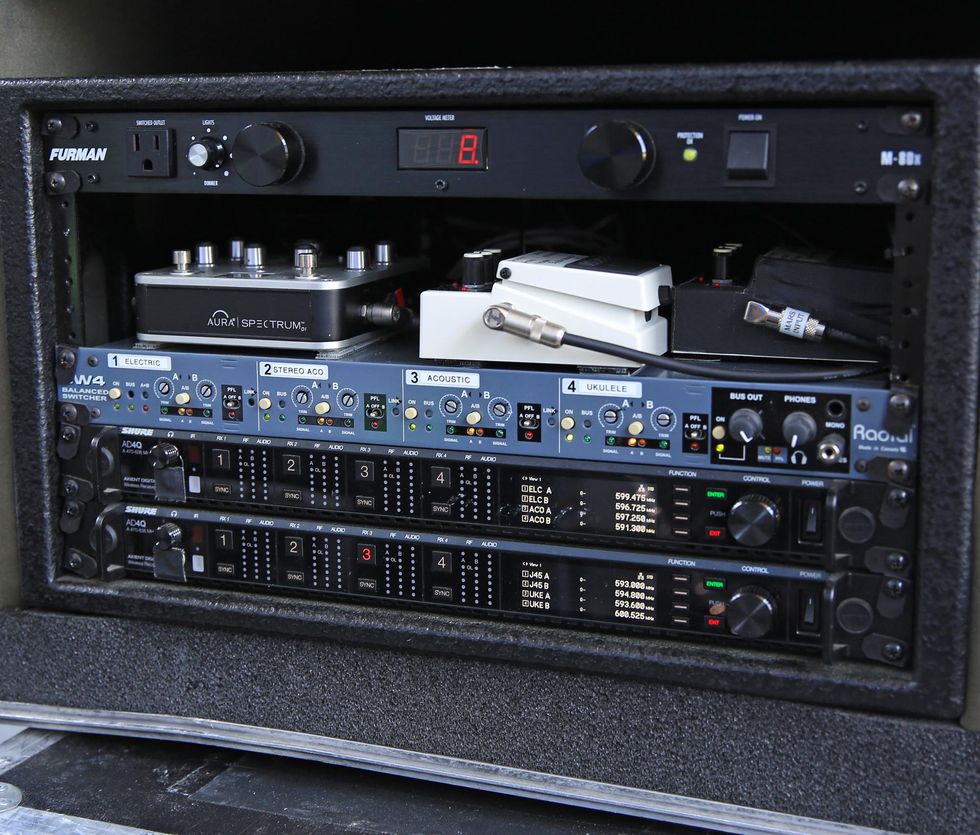
Locke’s electric guitar signal hits a Shure Axient Digital wireless and zooms into a Radial SW4 switcher. Tech Stephen Ferrera-Grand does the wireless switching on the Radial unit, in his guitar rack.
Above the SW4, you’ll see, peeking out, the acoustic boss: a Countryman DI. The Godin ukuleles follow the same signal flow as the acoustics, but along a different path into a separate Countryman DI.
Treading the Treadles
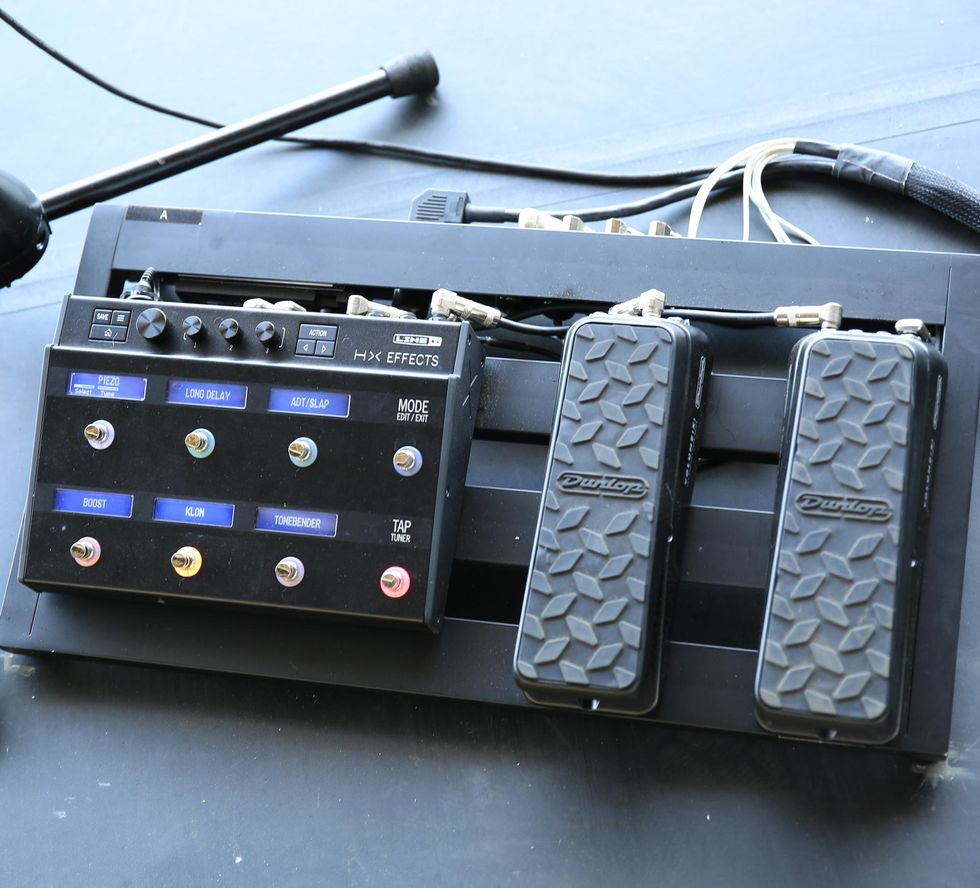
From the rack, the signal is sent out to a Pedaltrain ’board, outfitted with a Best-Tronics patchbay. The board contains a Dunlop DVP1XL volume pedal to a Line 6 HX. A second DVP1XL controls certain effects parameters, such as delay repeats and Leslie speed. The signal is then sent into a Boss NS-2 noise suppressor and on to the Top Hat amp.
Each speaker gets its own microphone: a Shure SM57 and an Audio-Technica AT4040.
For the majority of the set, Taylor keeps his HX set up with the following effects models: a Tone Bender fuzz (for leads and solos), a Klon Centaur (primary overdrive sound, almost always on), an MXR Timmy OD (neutral volume boost), EHX Deluxe Memory Man (modulated slap delay), Boss DM-2 Delay (long delay), and a Fender Vibratone (rotary). Taylor scrolls to other pedalboard scenes for song-specific effects, using tremolo for “Meet Virginia,” a Small Stone phaser for “AM Gold,” and so on.
Butterscotch Bliss
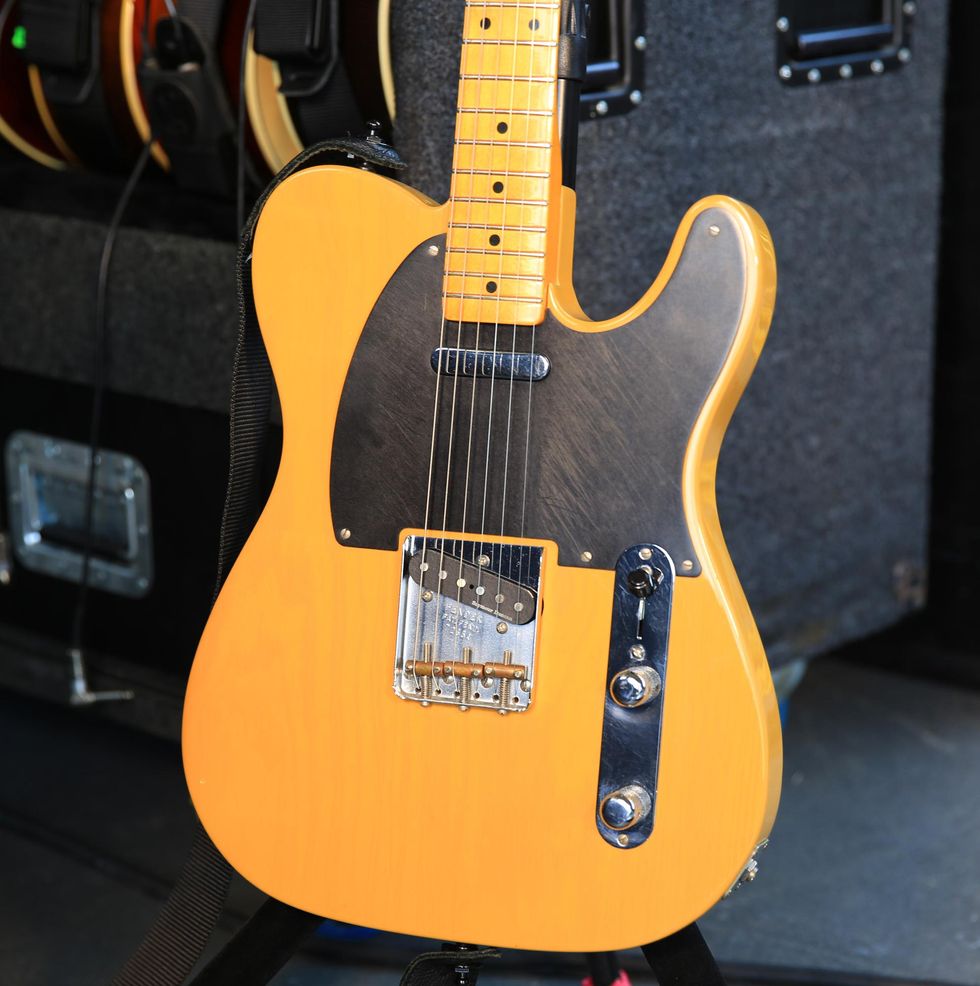
Another entry from the realm of the classics: Jerry Becker’s 2011 all-stock Fender American Vintage ’52 Telecaster has an ash body, a large U-profile neck, and, of course, a maple fretboard. It is strung with Dunlop DEN1046 Electric Nickel Performance+ string sets, running .010–.046. PS: Becker uses Levy’s straps and wireless pouches, Dunlop custom graphic signature picks, and Kyser Quick-Change capos.
Red Horse
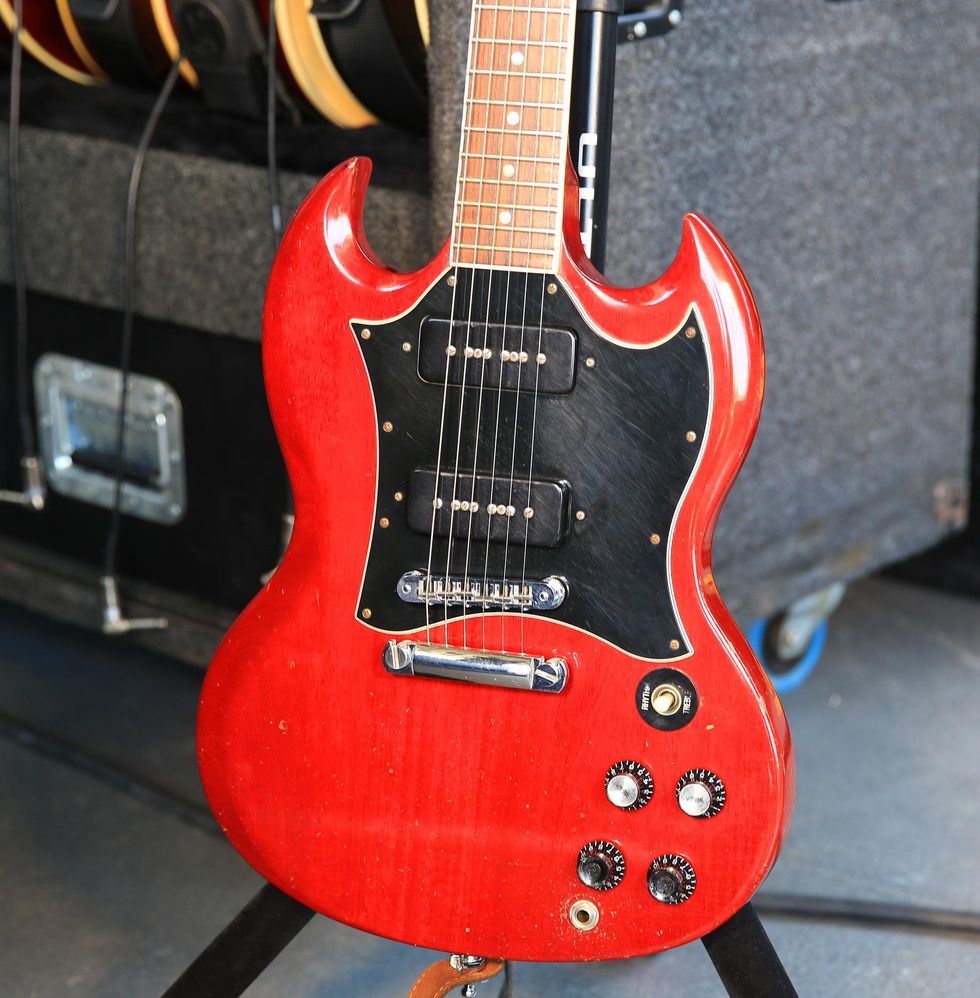
This Gibson SG Classic from 2010 is stock and strung with Dunlop Performance+ .010–.046 sets—as are all his electrics. It has P-90s, a rosewood fretboard, and pearloid dot inlays up the neck.
Guitar of the Beast
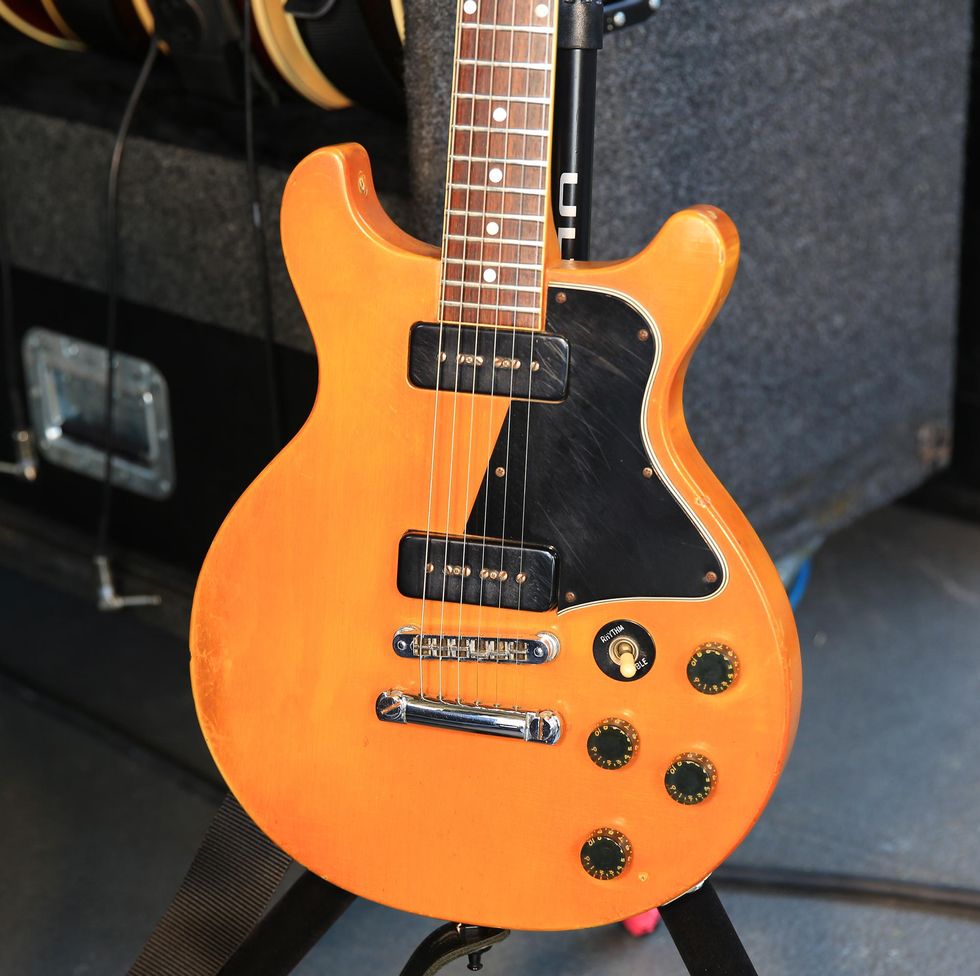
This second-generation Gibson Les Paul Special reflects the body style that led Les Paul himself to cut ties with Gibson in the early 1960s. Nonetheless, with their two P-90s and lighter slab bodies, these are killer guitars. The double-horn cutaways make this 1973 a rare beast. It’s stock.
All Stock and Ready To Rock
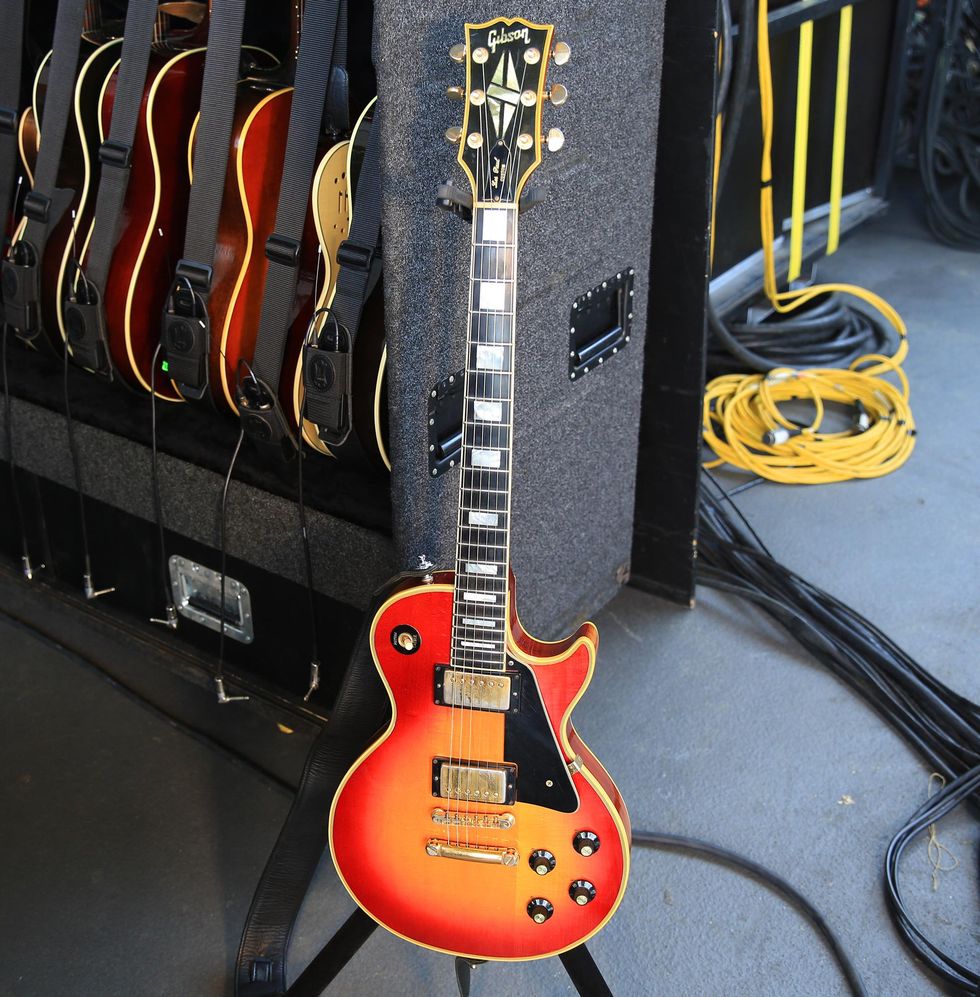
Here’s Becker’s 1973 Gibson Les Paul Custom, left as it came from the factory. As you may recall, this model comes with “banjo”-style fret wire, to earn their reputation as—as Gibson put it on the model’s introduction in 1954—fretless wonders.
Modern Classic
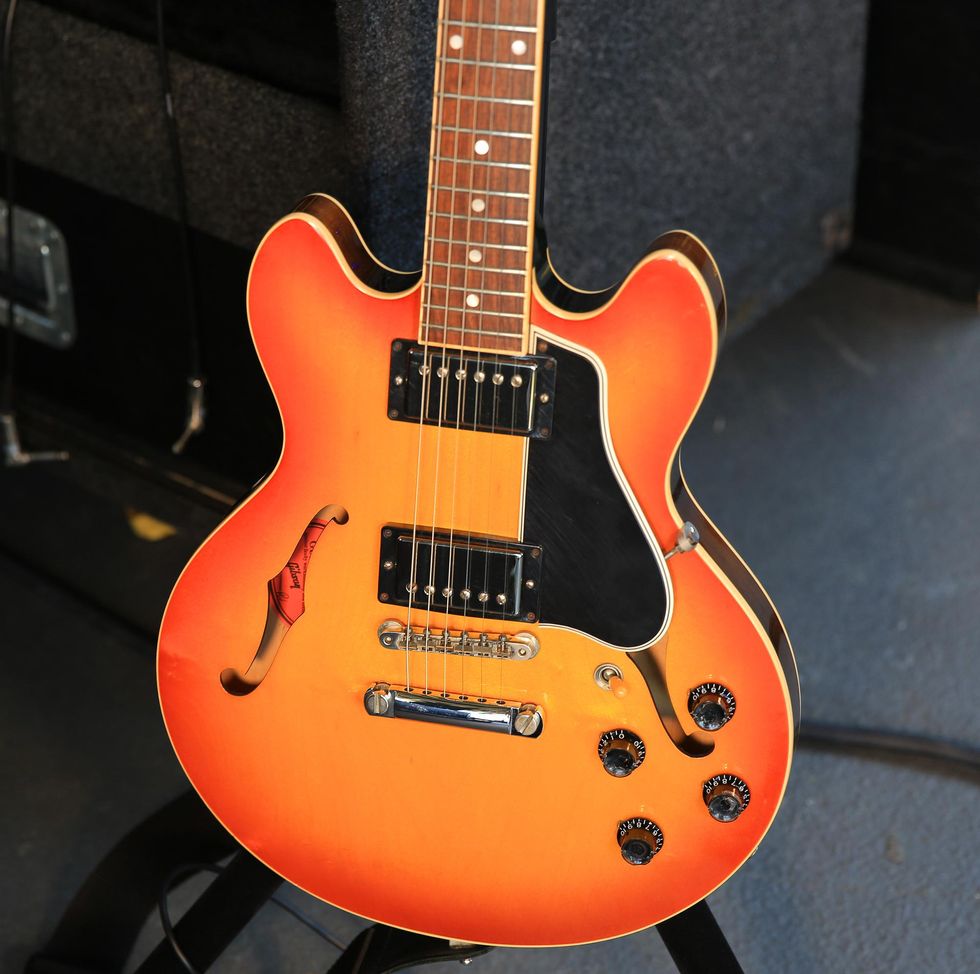
This Gibson ES-339 was built in the first year the model was issued: 2007. The company introduced this guitar as a smaller—Les Paul sized—take on the ES-335, with a laminated maple-poplar-maple body, a maple center block, and spruce contour braces.
One More 45

Here’s yet another of Train’s Gibson J-45s. This one is a 2013 Custom Shop model in a wine red finish, and it is strung with Elixir 11050 80/20 Bronze Polyweb lights, gauged .012 to .053.
Nashville Tuning
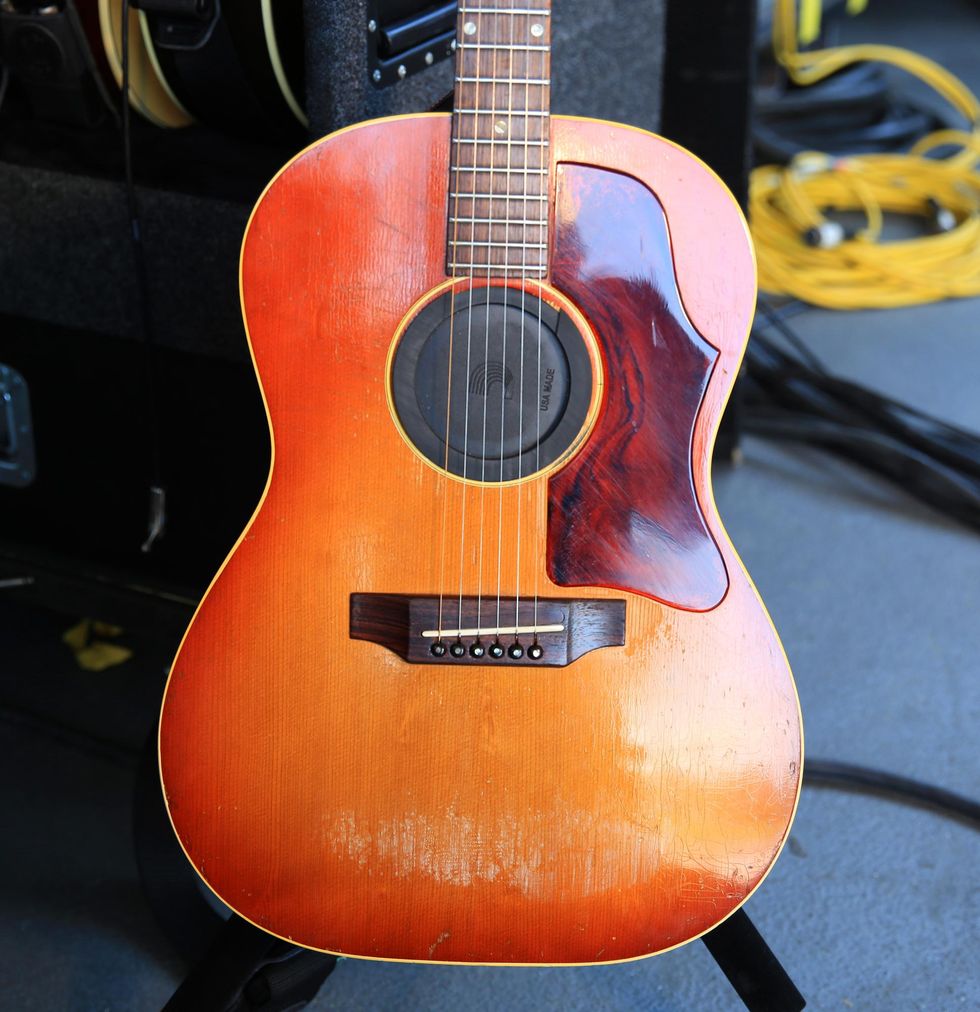
Becker’s 1966 Gibson B-25 is set up in Nashville, or high strung, tuning. In this tuning, the wound E, A, D, and G strings are replaced with lighter-gauge strings tuned an octave higher than usual. In the old days, this had to be done by raiding 12-string sets, but some modern string makers produce Nashville tuning sets. So, Becker uses D’Addario EJ38H Phosphor Bronze .010–.027s.
Canadian Nylon
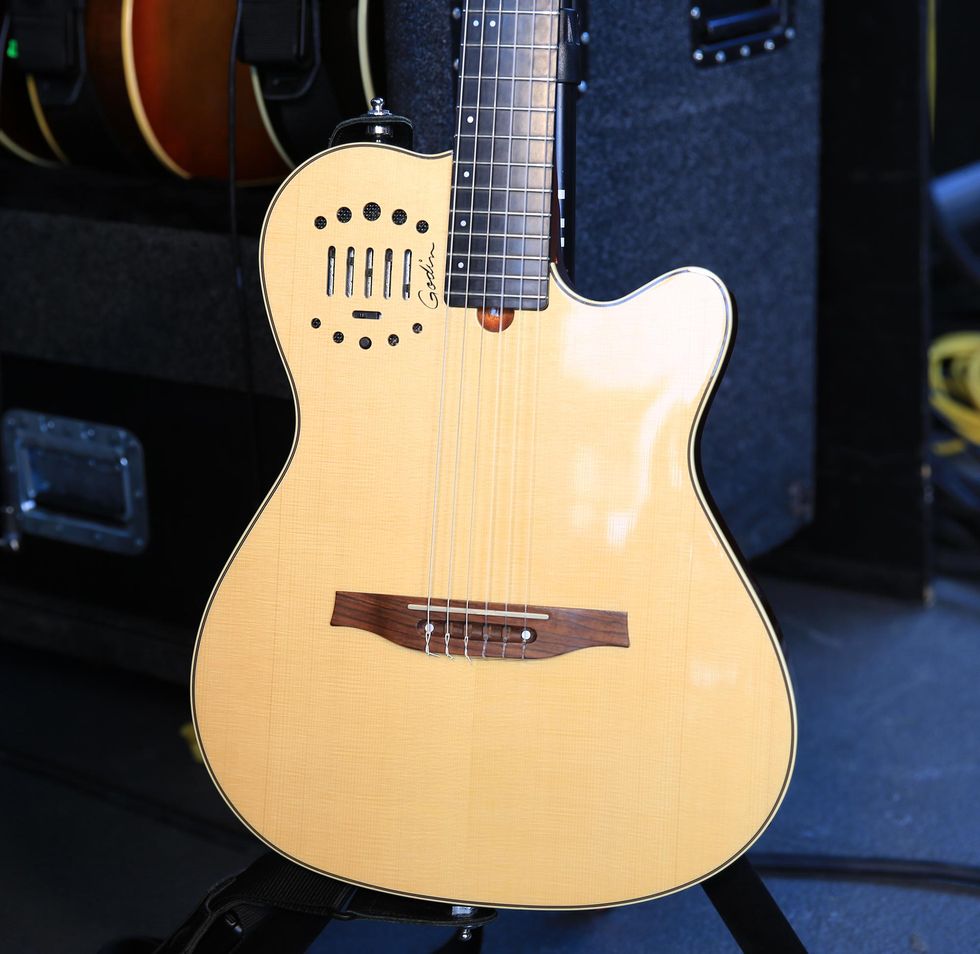
This 2017 Godin Multiac Nylon Duet Ambiance Natural HG has Fishman electronics that allows the internal blending of four microphone settings. It also sports a slim nut width (1.9"), a Richlite fretboard, and a chambered mahogany body. The strings: D’Addario EJ31 Pro-Arté Rectified Nylon Hard Tensions.
In the Pedal Pond
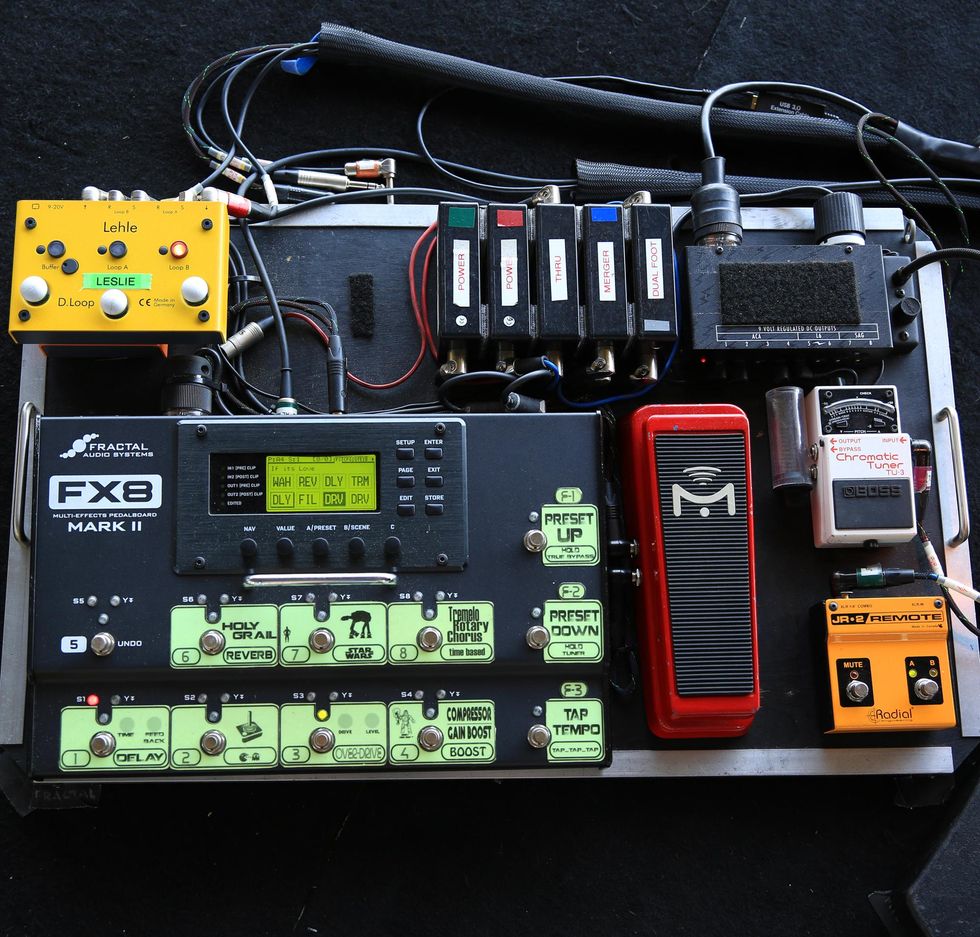
Becker uses a Fractal Audio Systems FX8 MkII combined with a Mission Engineering SP-1 Expression Pedal. There’s a Lehle D.Loop SGoS Loop Switcher, a Boss TU-3 Tuner, a Radial JR-2 Remote, and a Lehle P-Split Passive Splitter. It’s all powered by a Voodoo Labs Pedal Power 2 Plus.
But Wait, There’s More
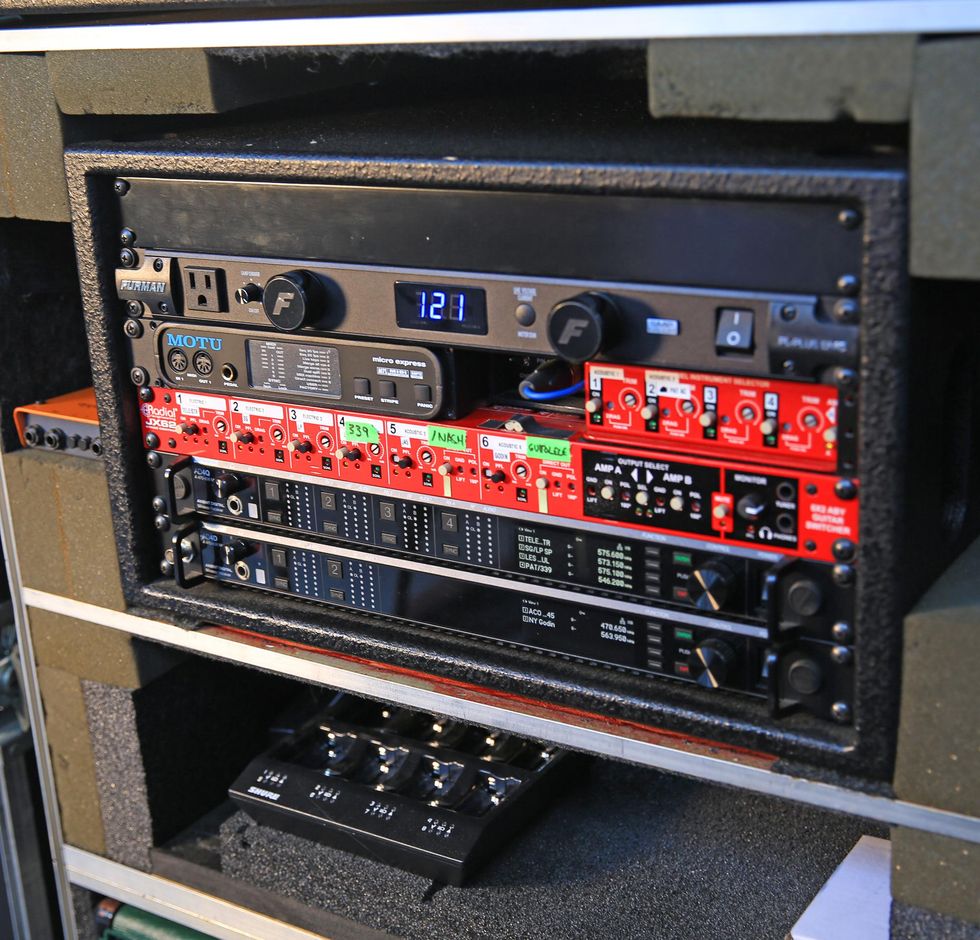
Guitar tech Wayne Davis mapped out Becker’s signal flow for us. The electric guitars hit a Shure Axient Digital Wireless receiver and flow into a Radial JX62. There, the 6-strings can be directed into the Lehle D.Loop in and then out via a loop A send to the Fractal FX8. The loop A return then reroutes through a D.Loop out to the Radial again. Then there are amp options: a Matchless DC-30 or a Leslie combo preamp and 145 rotary speaker cabinet. Acoustic guitar arrives via the wireless and hits the PA via the JX62 DI out.
Green Sound Machine
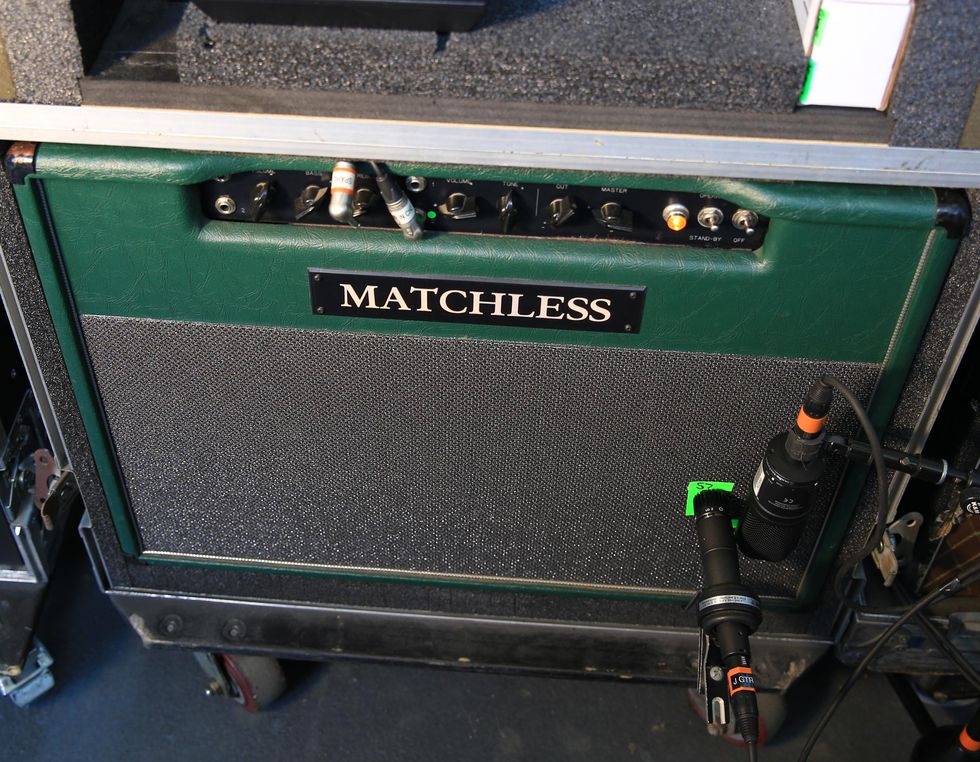
This envy-shaded DC-30 is Becker’s big gun. It was the company’s first design and gets huff from four EL84s, with two preamp sections: one powered by two 12AX7s and the other by a single EF86. That’s a lot of tonal versatility.
The Understudy
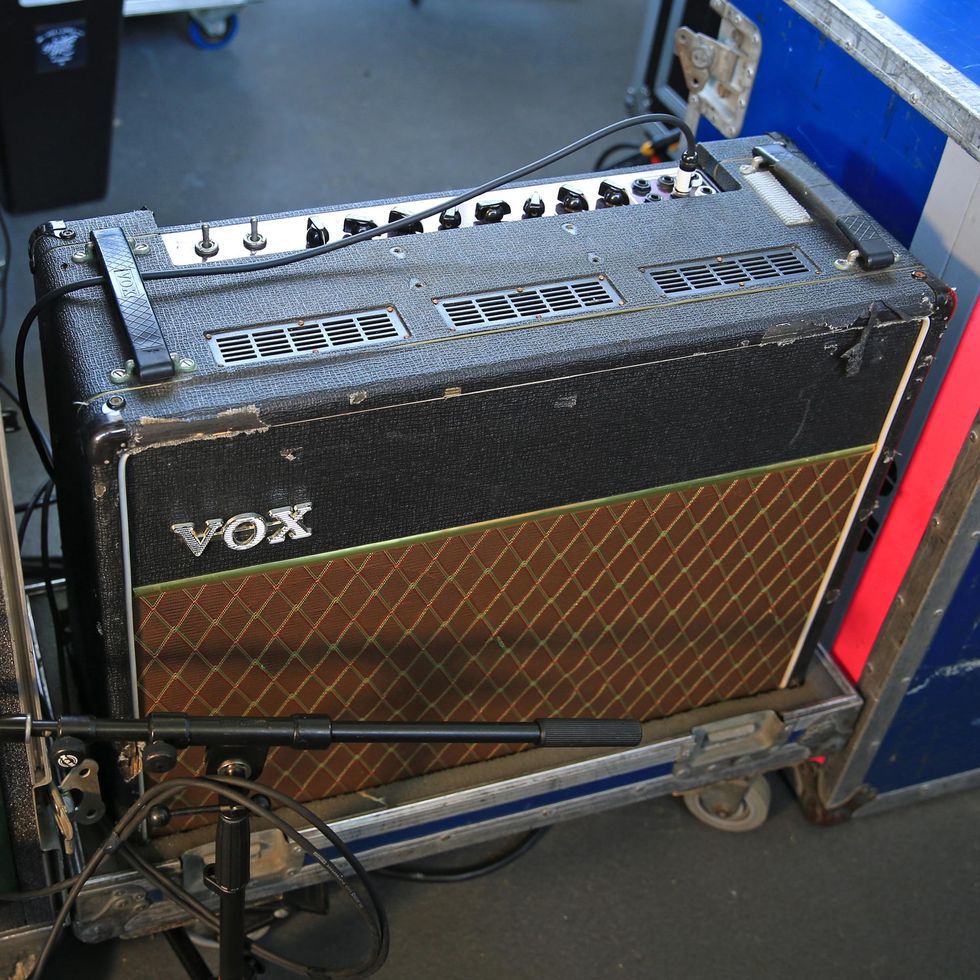
This Vox AC30 acts as Becker’s back up.
Coming Up Roses
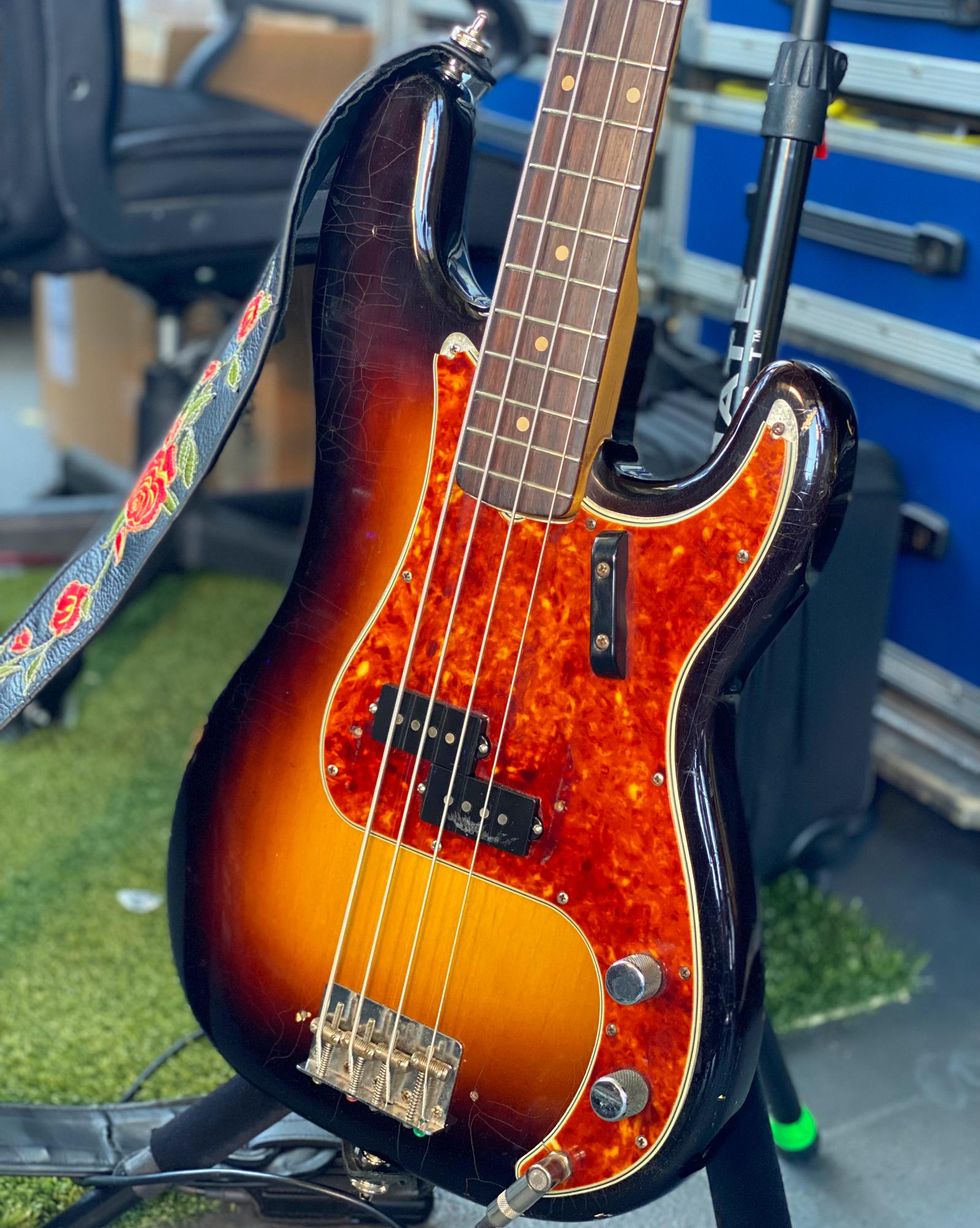
Bassist Hector Maldonado’s long search for an early ’60s P bass landed him this 1960 Fender Precision days before Train’s current summer tour. The gem was professionally refinished by Joe Riggio of Riggio Custom Guitars at some point, but other than that it’s as Leo intended over 60 years ago. Riggio helped connect Maldonado to the seller so he could acquire his dream bass.
No. 2
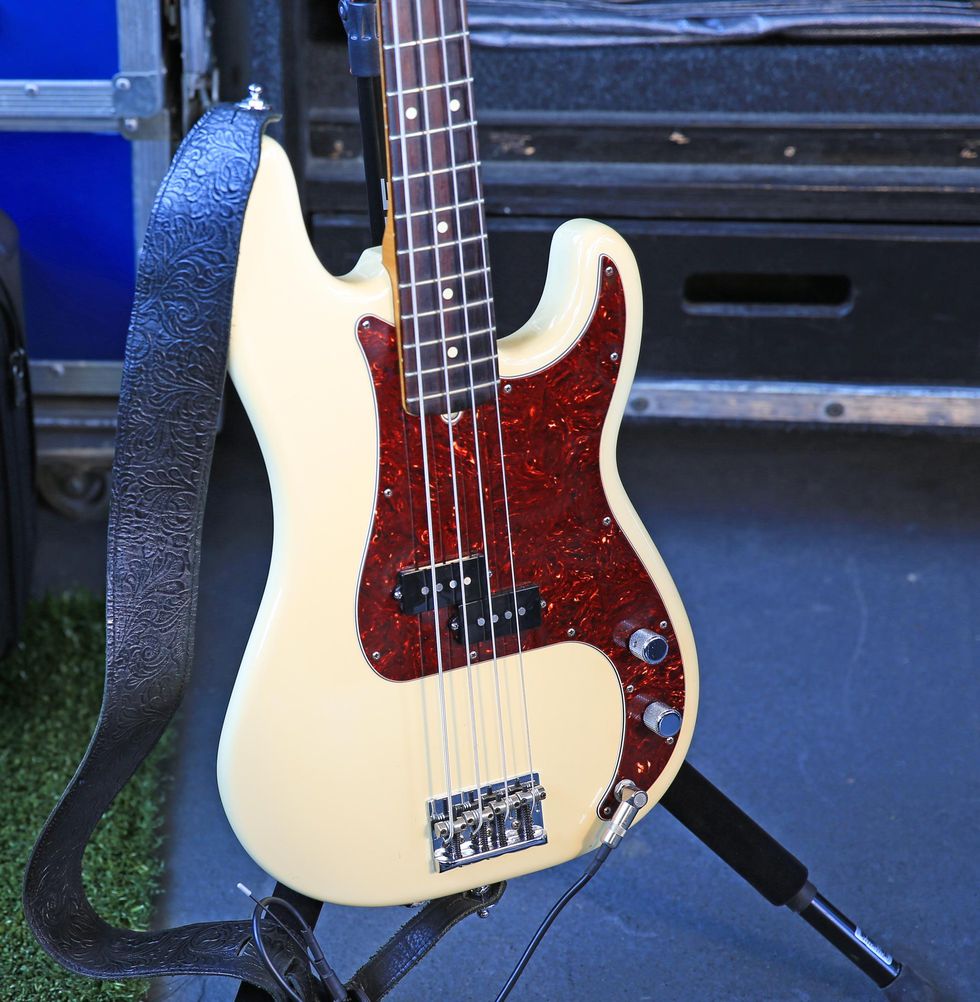
With the arrival of his new old P, this off-the-rack Fender American Vintage ’62 P bass reissue got demoted to the No. 2 slot. But Maldonado says it plays better than some of his vintage instruments, and this 4-string has been around the world a few times with Train. Both Fenders take D’Addario roundwounds (.045–.100).
Sir Paul’s Highball
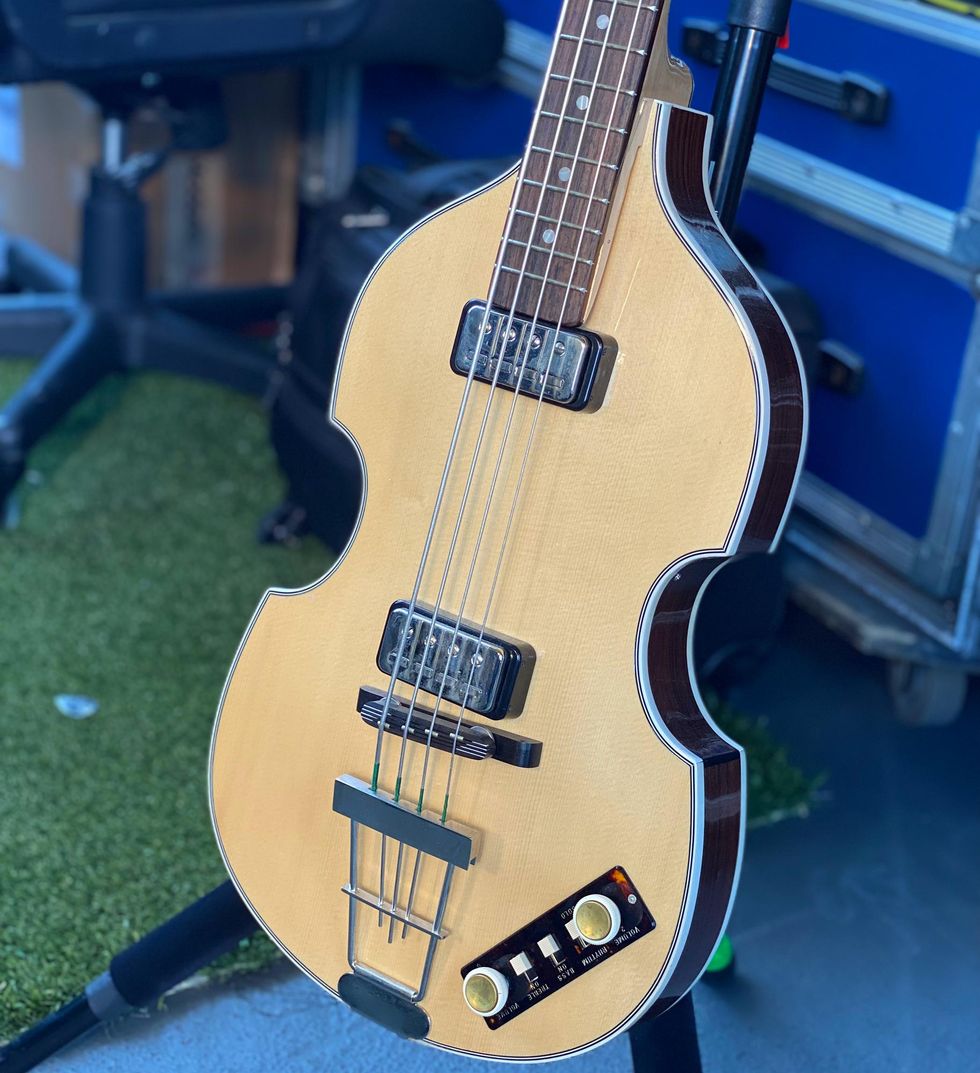
If you’ve spent time with any of the last three Train albums, you’ve heard this limited-run Hofner Gold Label Violin Berlin model. It is made of German Nussbaum wood and has the company’s 511B staple pickups in a normal-spacing configuration. Hofner’s Gold Label instruments are highly limited editions.
Get Back!
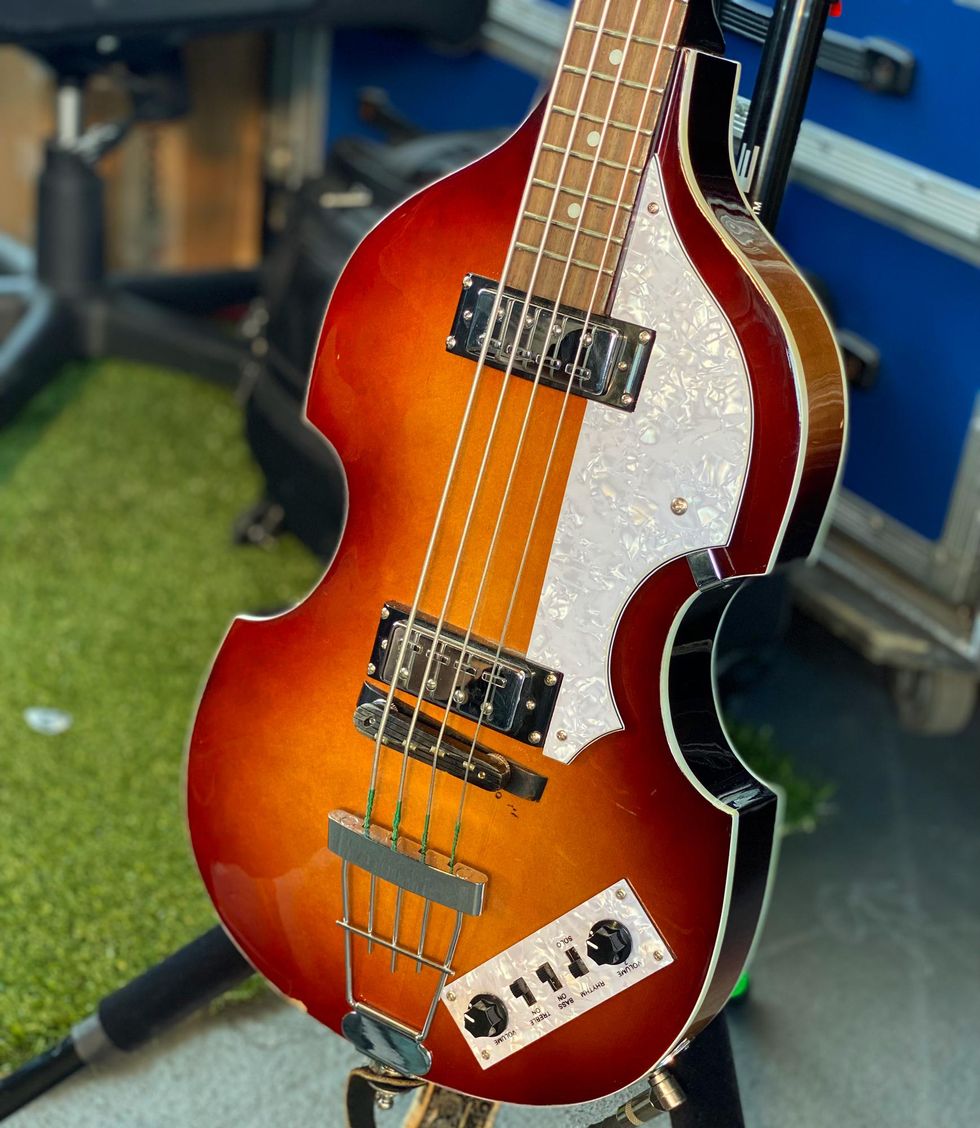
For the ultimate Beatles’ vibe, Maldonado uses this Hofner B-Bass HI-Series Violin model. It provides the desired “pluck” sound of 1964. Both of his stage Hofners take D’Addario XL Chromes, flatwound (.045–.100).
Spanish Flair

“Cleopatra” off AM Gold has a flamenco guitar part. Maldonado is classically trained, so he was the obvious choice to handle it, plus Becker and Locke are already busy with their own guitar chores on the song. Hector’s setup on his Yamaha CG172SF is creative. He uses a blend of strings from his Fender Bass VI and nylon guitar strings to hold down the low end and shred fingerstyle.
Racked and Ready
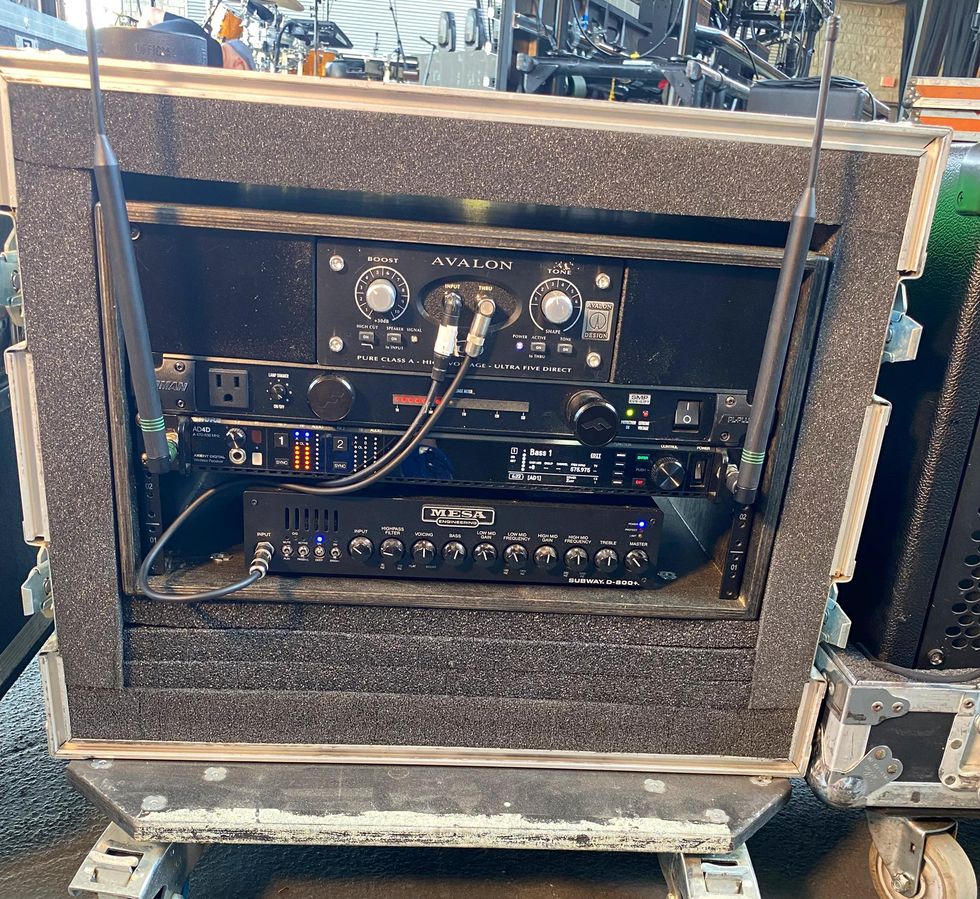
A Mesa/Boogie Subway D-800+ powers his basses, while an Avalon U5 Class A Active Instrument DI give a clear signal to front-of-house. And like his compatriots, he’s running a Shure AD4D rackmount wireless system.
More on the Floor
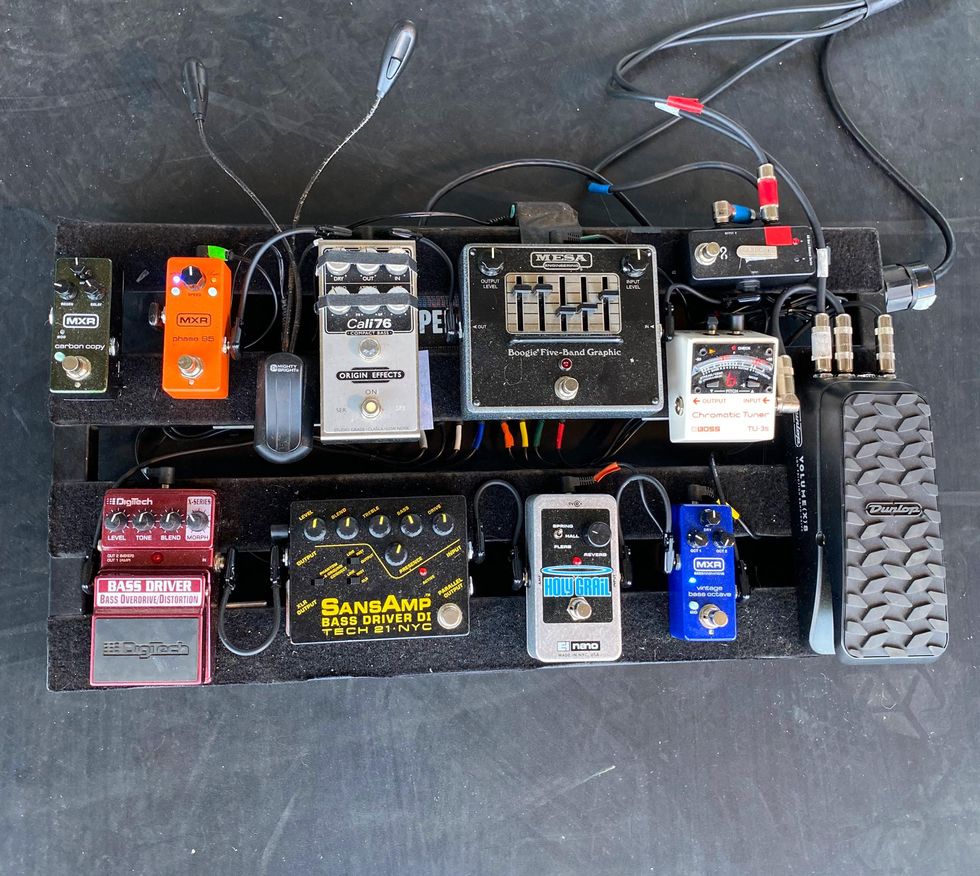
Maldonado has more pedals on the floor than his fellow Trainmen. His stomp station consists of a trio of mini MXRs—a Carbon Copy, Phase 95, and Vintage Bass Octave—plus an Electro-Harmonix Holy Grail Nano reverb, a Tech 21 SansAmp Bass Driver DI, a DigiTech Bass Driver OD, an Origin Effects Cali76 compressor, and a Mesa/Boogie Five-Band Graphic EQ. A Dunlop Volume (X) DVP3 and a Boss TU-3s mini Chromatic Tuner keeps his instruments reined.




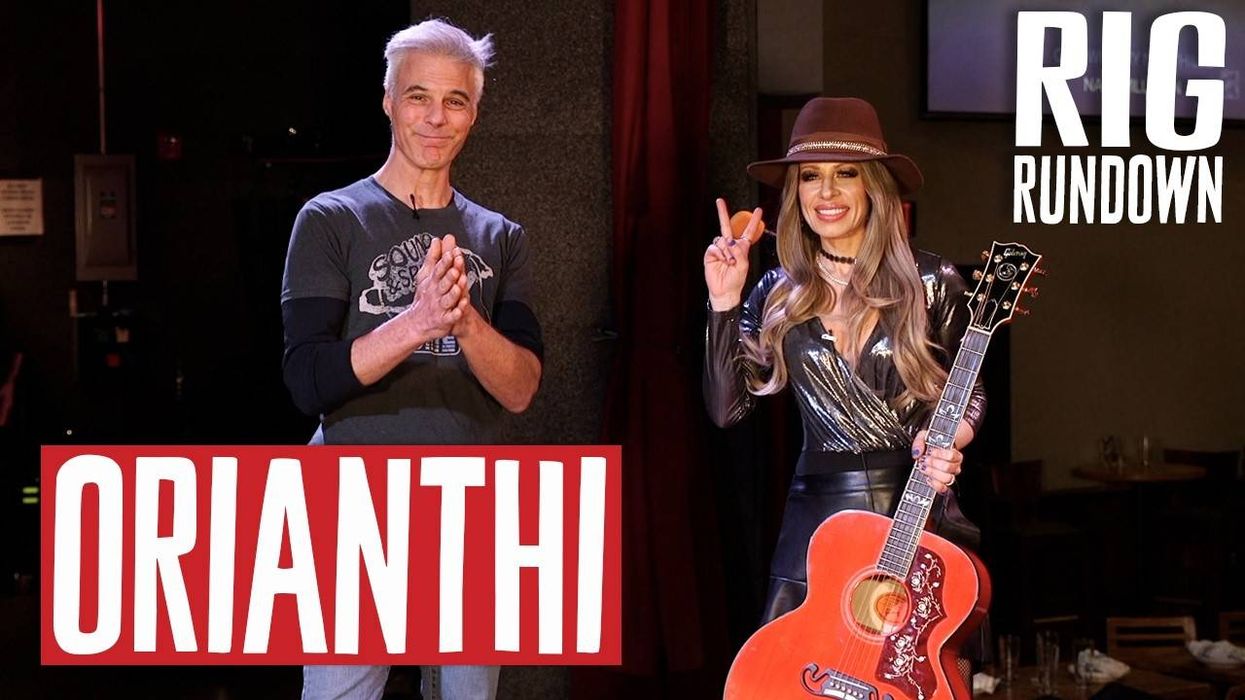
![Rig Rundown: AFI [2025]](https://www.premierguitar.com/media-library/youtube.jpg?id=62064741&width=1245&height=700&quality=70&coordinates=0%2C0%2C0%2C0)












 Shop Scott's Rig
Shop Scott's Rig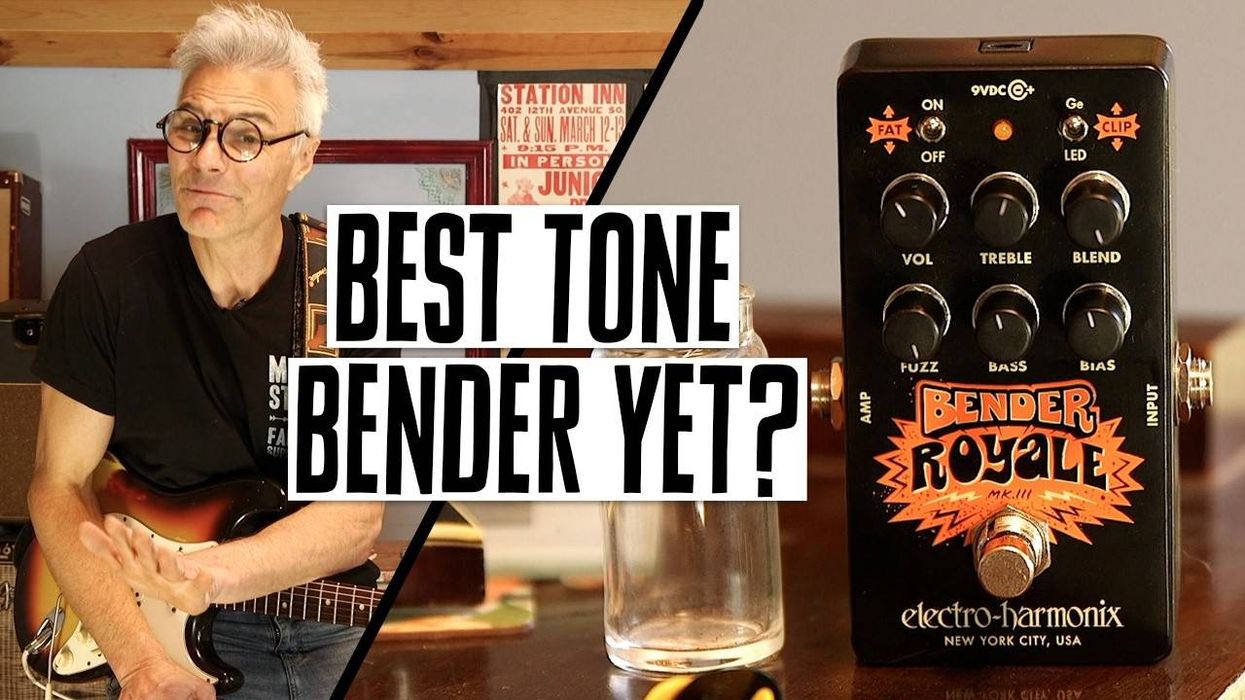
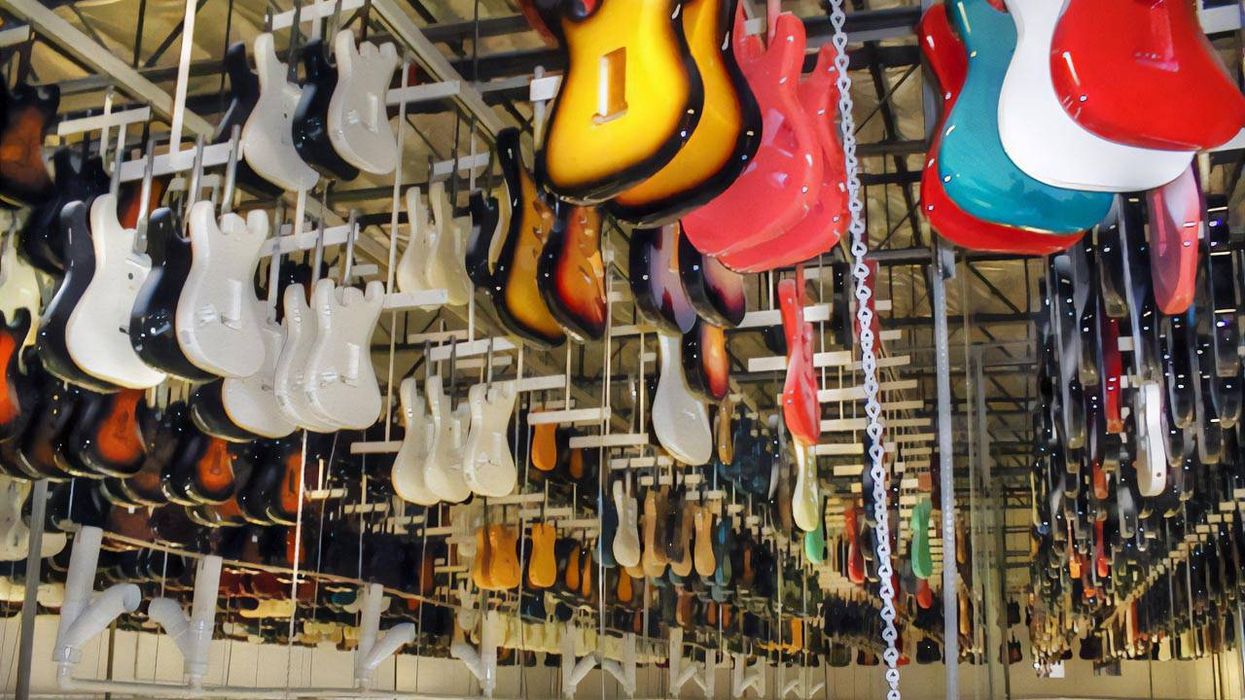

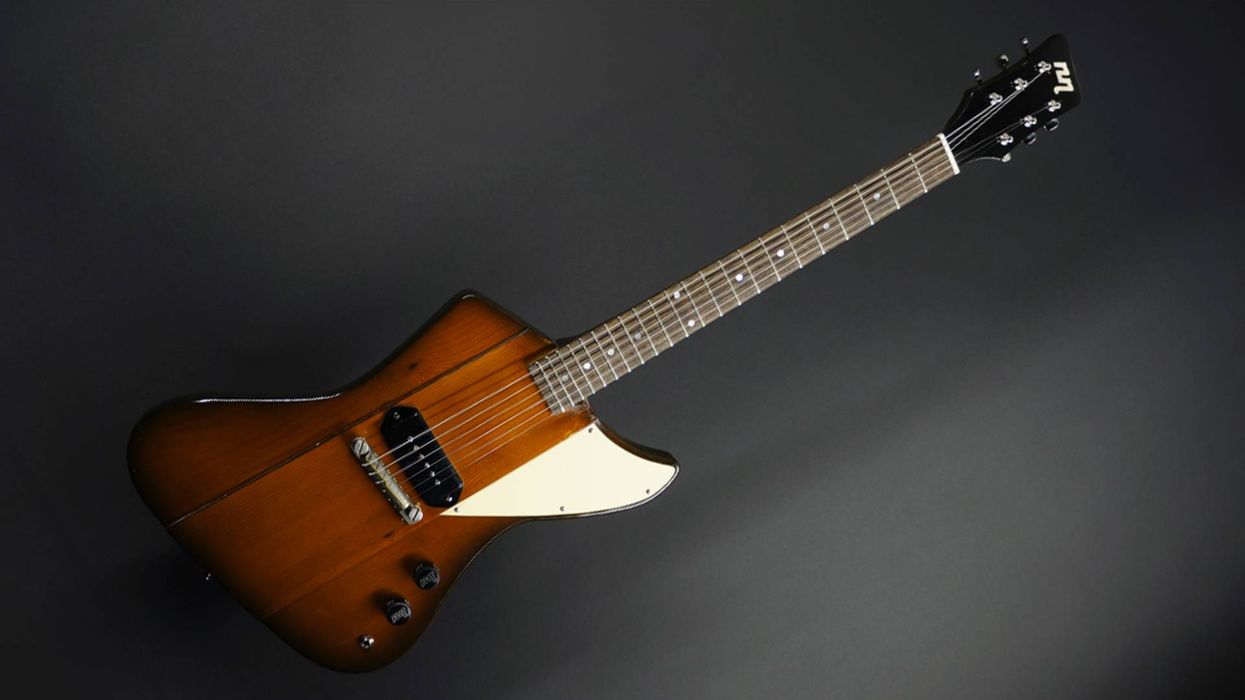

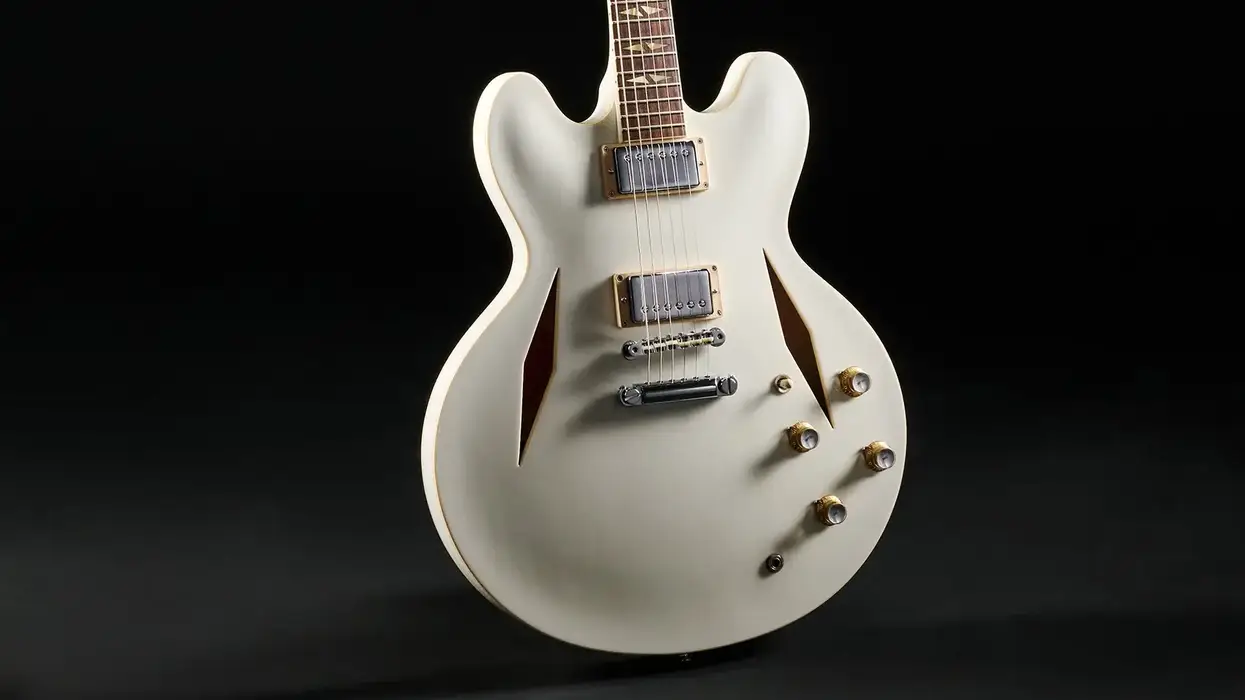
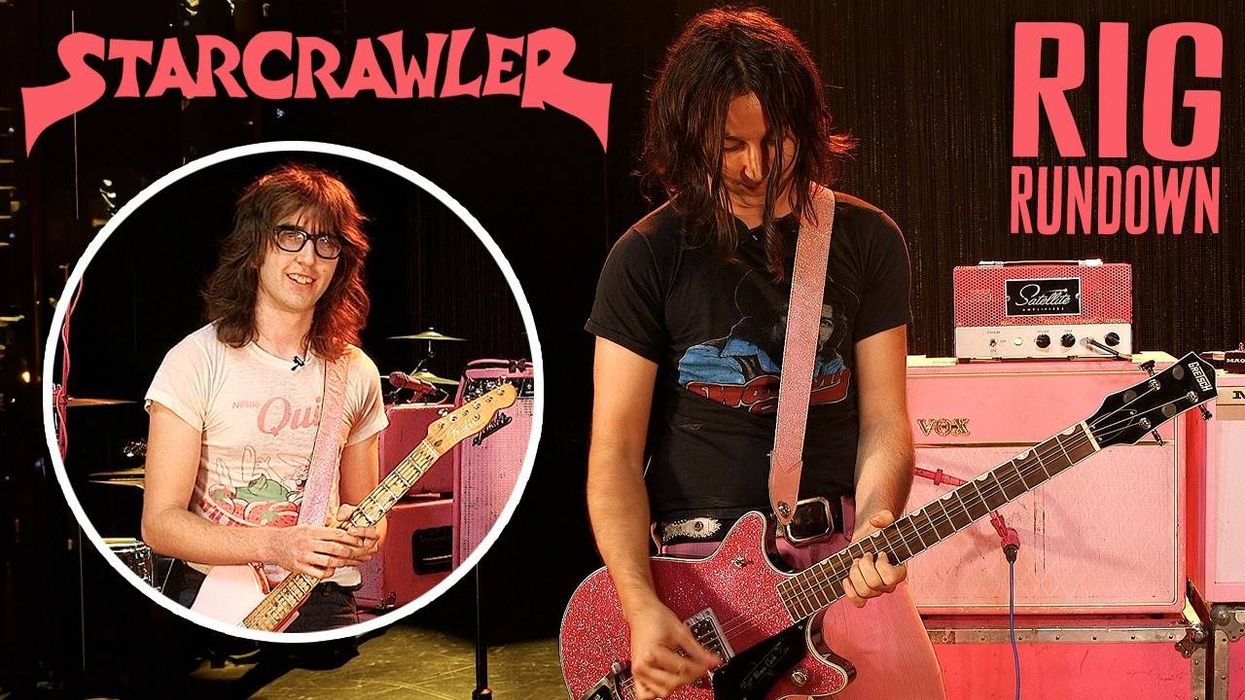
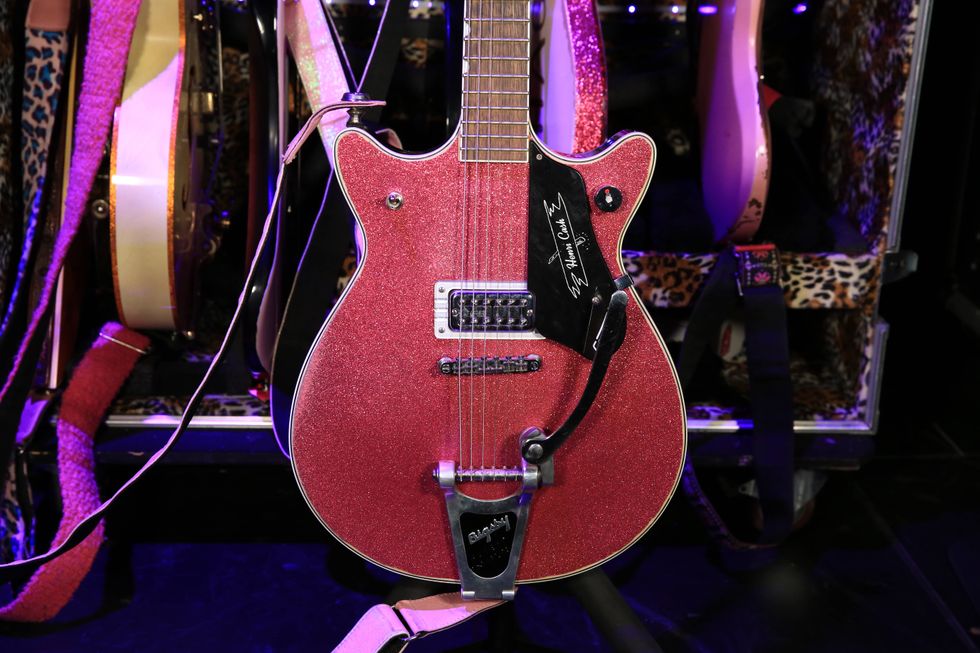
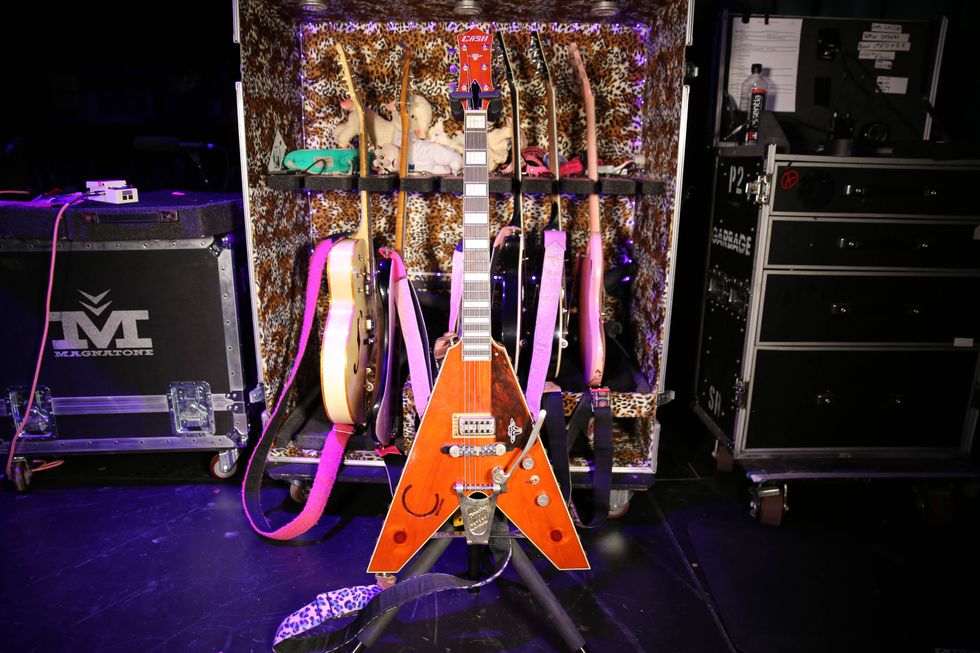
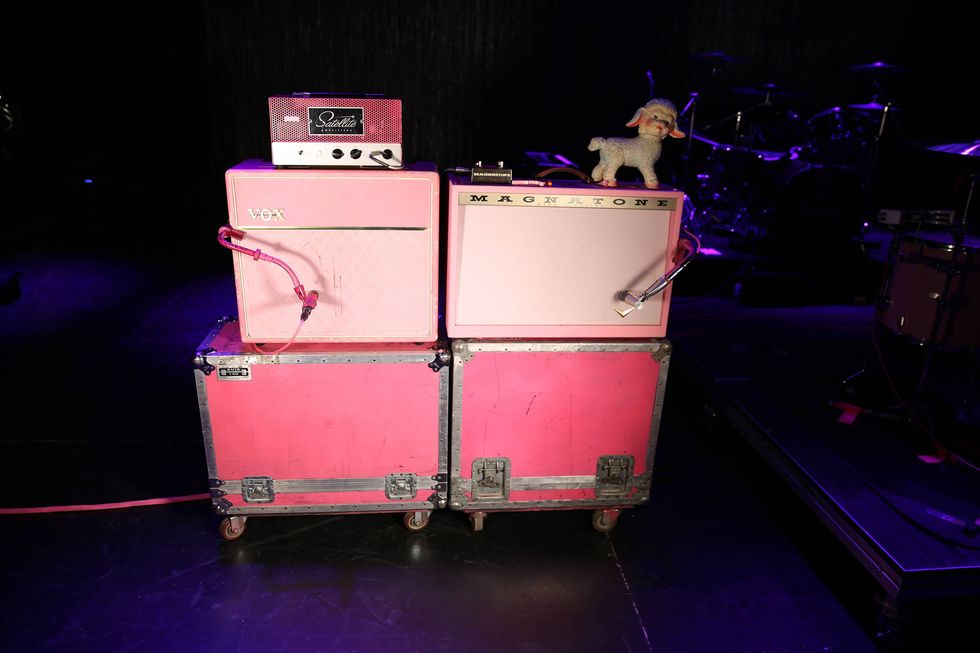
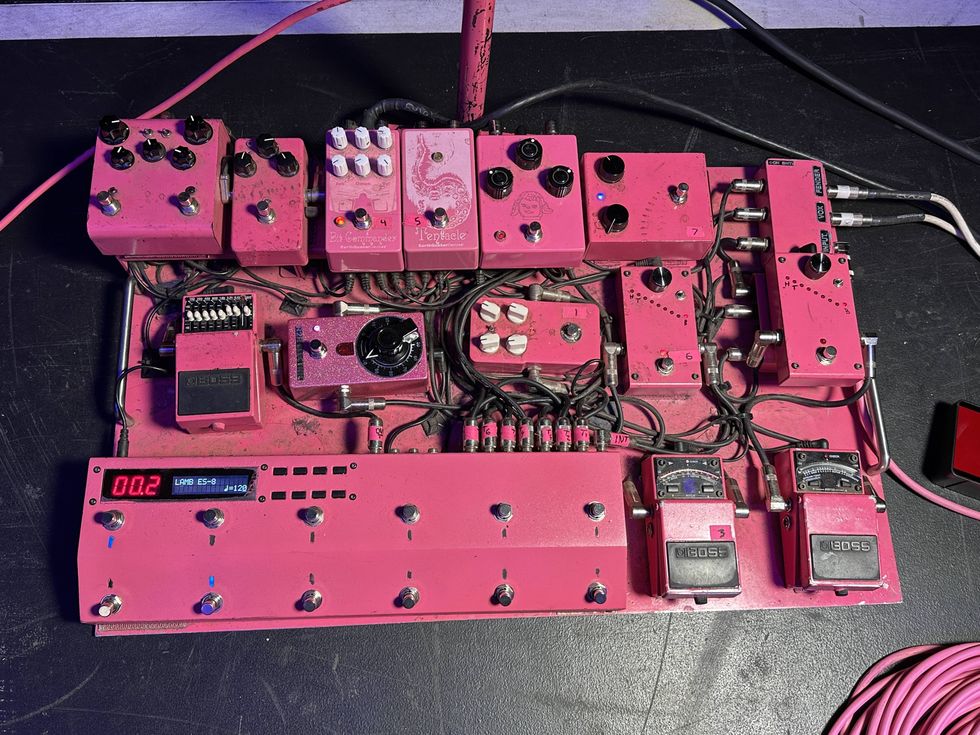
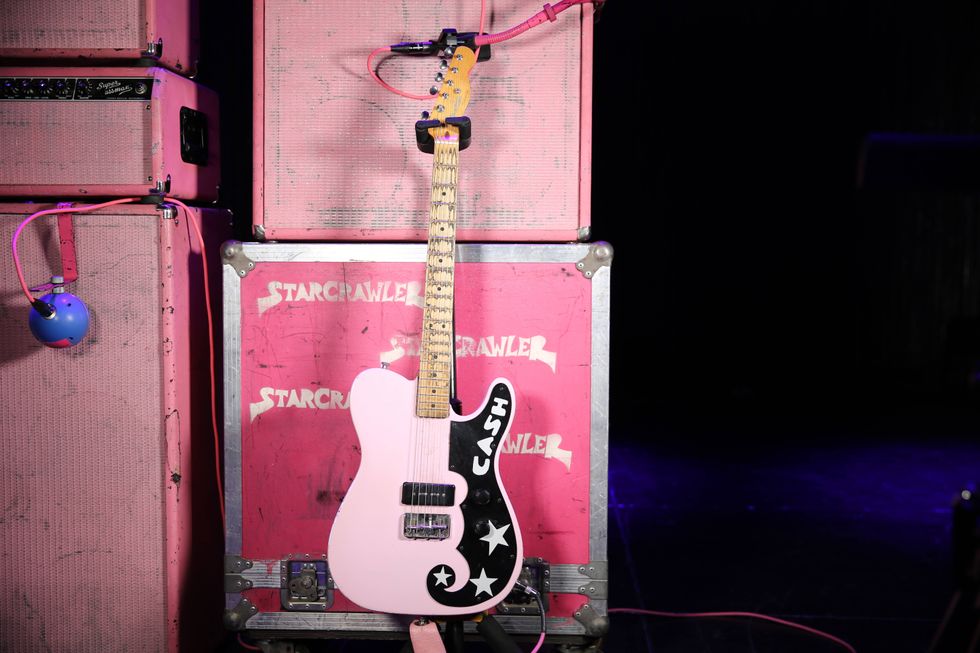
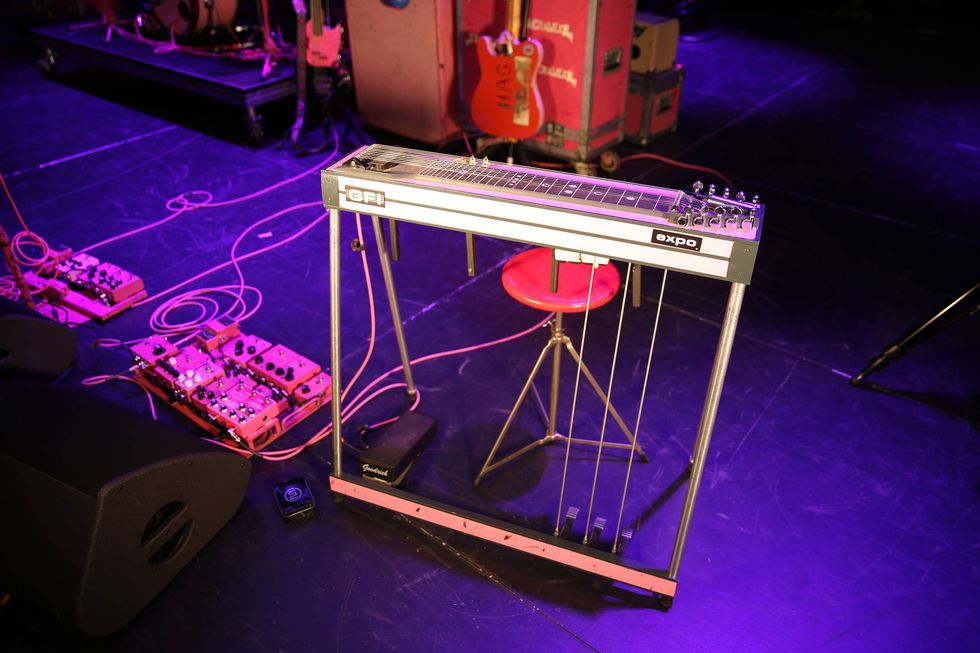
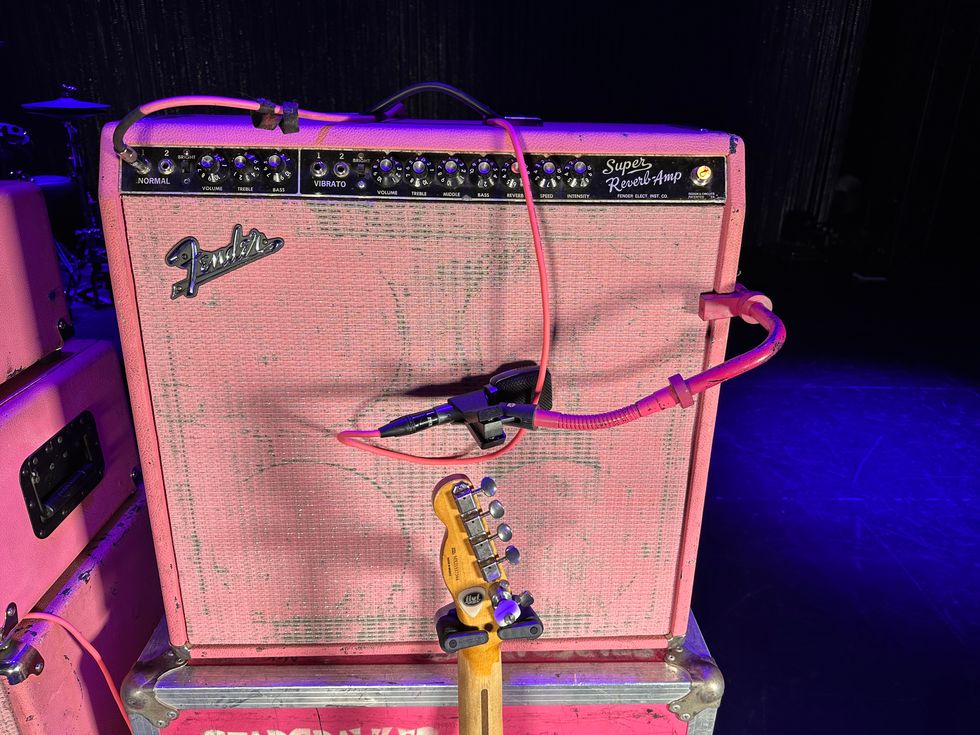
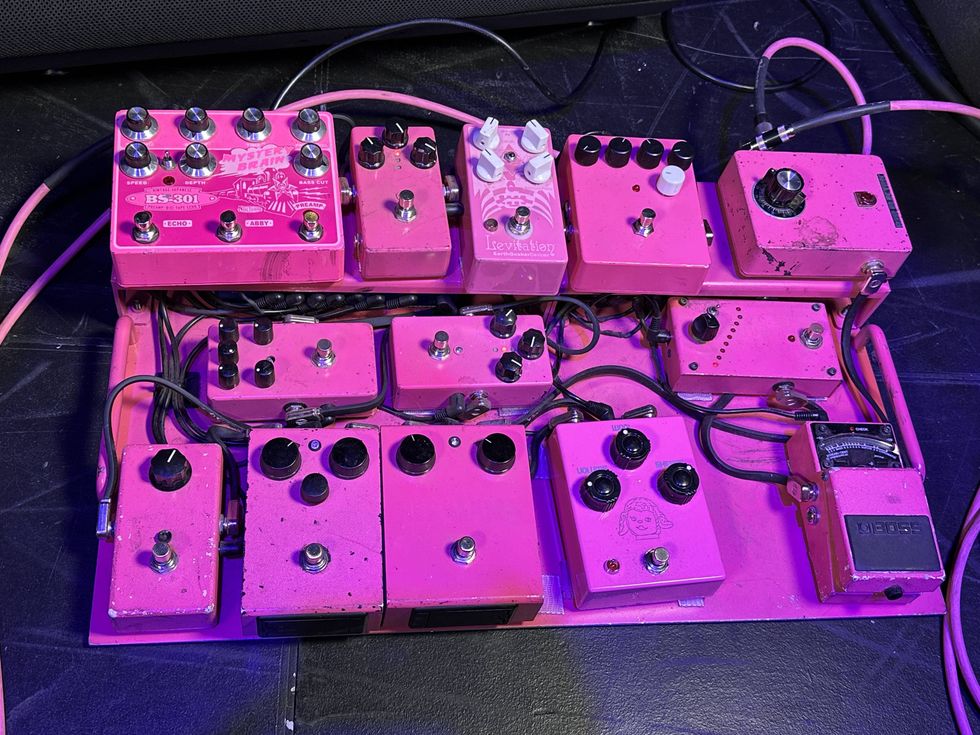

![Devon Eisenbarger [Katy Perry] Rig Rundown](https://www.premierguitar.com/media-library/youtube.jpg?id=61774583&width=1245&height=700&quality=70&coordinates=0%2C0%2C0%2C0)
